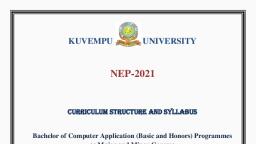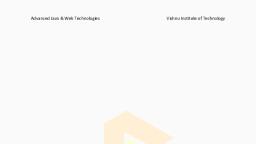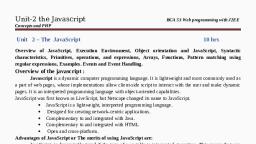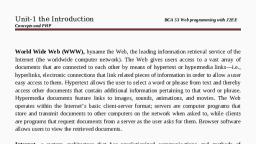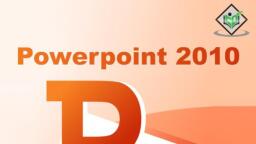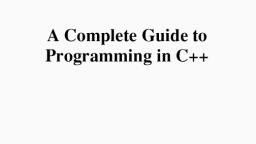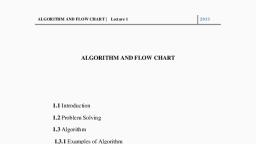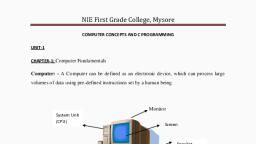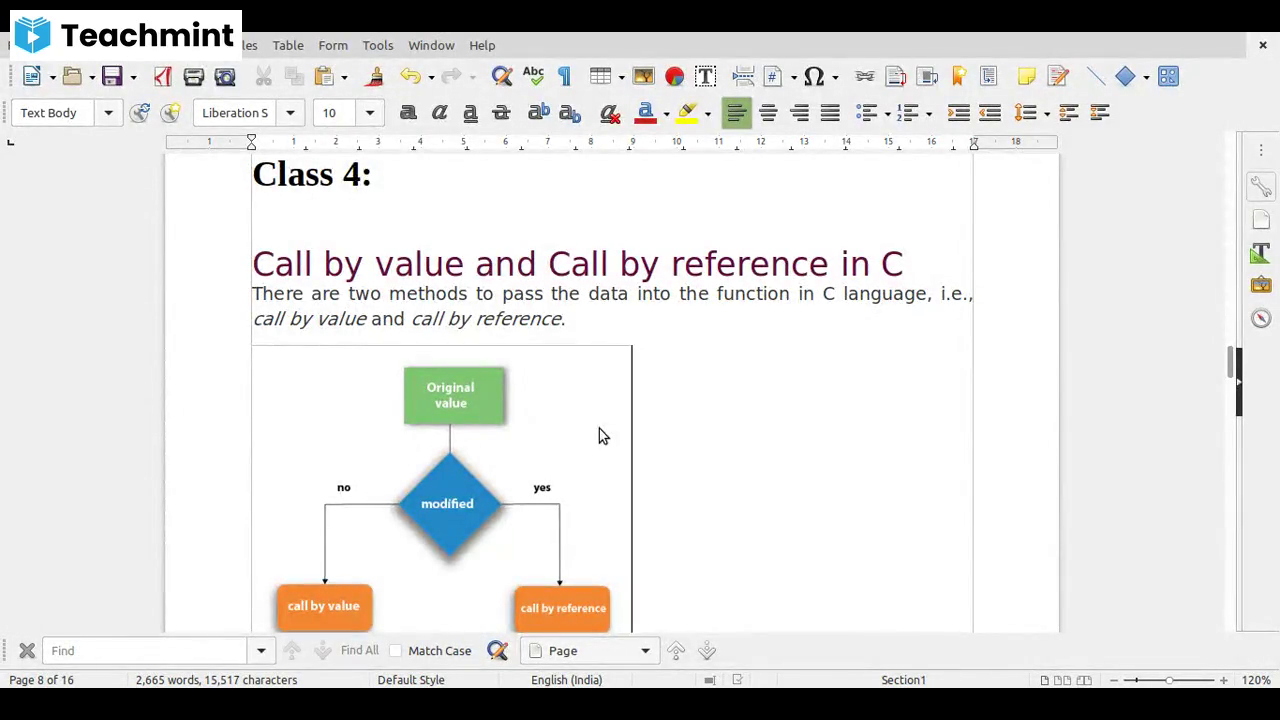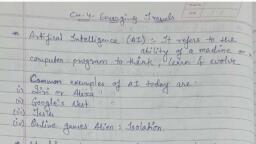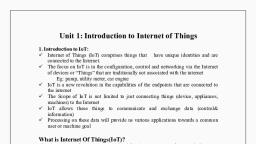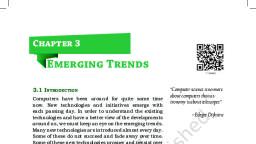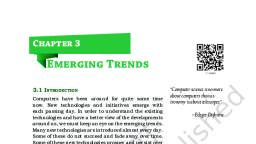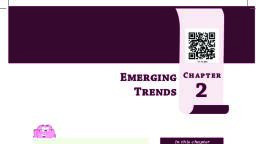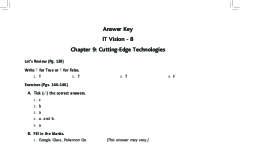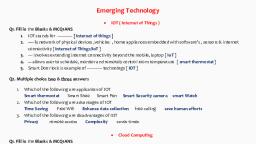Page 2 :
Table of contents, Contents of Digital Fluency course are taken from Digital 101 course on Future Skills Prime Platform of NASSCOM, , SlNo., , Contents, , Page No, , 1., , Syllabus of Digital Fluency, , 2, , 2., , Regarding Future Skills Prime, & Digital 101 Courses, , 4, , 3., , Module 1, , 25, , 4., , Module 2, , 91, , 5., , Module 3, , To be Shared Later, , 1
Page 3 :
Digital Fluency, Course Title: Digital Fluency, Total Contact Hours: 15 hours of theory and 30 hours of, practicals, Formative Assessment Marks: 40 marks, , Course Credits: 2, Duration of ESA:, Summative Assessment, Marks: 60 marks, , Course Content: In concurrence with Digital 101 on Nasscom 101 environment, Sl.no, Content, Details of topic, Duration, 1., Registration, Future Skills Course Registration Process, Overview of Emerging Technologies:, i. Artificial Intelligence, Machine, 05 Theory, Learning, Deep Learning,, hours and, Module 1:, ii. Database Management for Data Science,, 10, Emerging, 2., Big Data Analytics,, practical, Technologies, iii. Internet of Things (IoT) and Industrial, hours, Internet of Things (IIoT), iv. Cloud computing and its service models, v. Cyber Security and Types of cyber, attack, Applications of emerging technologies:, 05 Theory, Module 2:, i. Artificial Intelligence, hours and, Applications of, ii. Big Data Analytics, 10, Emerging, 3., iii. Internet of Things, practical, Technologies, iv. Cloud Computing, hours, v. Cyber Security, , 4., , Module 3:, Building, Essential Skills, Beyond, Technology, , Importance of the following:, i. Effective Communication Skills, ii. Creative Problem Solving & Critical, Thinking, iii. Collaboration and Teamwork Skills, iv. Innovation & Design Thinking, v. Use of tools in enhancing skills, , 05 Theory, hours and, 10, practical, hours, , References to learning resources:, 1. The learning resources made available for the course titled “Digital 101” on Future Skills Prime, Platform of NASSCOM, , 2
Page 4 :
Pedagogy, Flipped classroom pedagogy is recommended for the delivery of this course., For every class:, 1.Before coming to the class students are expected to go through the content (both video and other, resources) on the related topic and give the quiz on Future Skills Prime Platform of NASSCOM., 2.Class room activities are designed around the topic of the session towards developing better, understanding, clearing misconceptions and discussions of higher order thinking skills like, application, analysis, evaluation and design., 3.Every theory class ends with announcement of exercise for practical activity of the week, Assessment, Formative Assessment, Assessment Occasion, 1. After watching videos of each topic, 05 marks tests, are to be given by the students on Future Skills Prime, Platform. The total marks earned by students is to be, computed., 2. Formative Assessment (Internal Assessment): All, activities and Practical sessions from Module 1,, Module 2 and Module 3 need be completed by, students. All the activities are expected to be done in, teams with each team comprising of 02 -03 students., Each of Module 1 and Module 2 carry 15 marks, weightage and Module 3 carries 10 marks weightage., , Weightage in Marks, No weightage, , 40%, , Summative Assessment, University will conduct examination which carries, 60 marks weightage., , 60%, , In addition, after completion of all 3 modules students will be giving final assessment with 30, questions (30 min) on Digital course on Future Skills Prime platform. Students will have, maximum of two attempts and those who score at least 50% marks will get certificate from, NASSCOM., , 3
Page 5 :
NASSCOM Future skills Prime, & Digital 101 Courses, , 4
Page 6 :
Future Skills Prime – REGISTRATION PROCESS, , Click on the link / Copy & Paste in browser, https://futureskillsprime.in/, , 5
Page 7 :
Futureskills First Page Looks Like This - Click on Signup and Register, , 6, , Click here
Page 8 :
Or Click here, 2nd Page You Start The Registration Process by clicking the Login Tab, , Click here, , 7
Page 9 :
Click on Sign up & Create Account Using Your email id and tick check box, , 8
Page 10 :
Post your registration a Verification email will be send to registered email id, , 9
Page 11 :
Open your email and confirm your email address, , 10
Page 12 :
Once you confirm email ID, fill in the details as shown in image & click next, , 11
Page 13 :
Fill all the details as shown on the screen & click next, , 12
Page 14 :
Select Occupation and Education details & click Next, , 13
Page 15 :
Select any 3 knowledge areas of your interest & click complete the registration, , 14
Page 16 :
Login on Prime and Start Your Learning Journey on Future Technologies and Profession skills, , Ask Techie for any help, , 15
Page 17 :
Digital 101 Course Enrolment Process, , 16, , 13
Page 18 :
Lets Get Started with digital 101 Course Sign-in on FS Prime and this will be your first screen, click on, “GROUPS” on the top ., , 17
Page 19 :
Then click on “Other public groups” ., , 18
Page 20 :
Then please “Join” at “Campus to Corporate” group., , 19
Page 21 :
Now click on “Campus to Corporate”, , 20
Page 22 :
Hence now you start the courses from “Module 1”., , 21
Page 24 :
DIGITAL FLUENCY E-MANUAL, , Digital Fluency, E-Manual, Module-1, , 23
Page 25 :
DIGITAL FLUENCY E-MANUAL, , TABLE OF CONTENTS, , SL. NO, , TOPIC, , PAGE NO., , 1., , Artificial Intelligence, Machine, Learning, Deep Learning,, , 25, , 2., , Database Management for Data, Science, Big Data Analytics,, , 44, , 3., , Internet of Things (IoT) and Industrial, Internet of Things (IIoT), , 51, , 4., , Cloud computing and its service, models, , 63, , 5., , Cyber Security and Types of cyber, attack, , 24, , 73
Page 26 :
DIGITAL FLUENCY E-MANUAL, , 1. ARTIFICIAL INTELLIGENCE, MACHINE LEARNING, DEEP LEARNING, An Overview of Artificial Intelligence:, AI is touching us in all aspects of our daily lives, most of the times unknowingly. Whenever we shop online,, use our mobiles, drive to work daily, check our mail box or exercise, AI is coming into play and helping us,, prodding us or controlling us. Since AI is already such an integral part of our lives, it makes sense to get, more knowledge of this emerging technology., From chess-playing computers to self-driving vehicles, Artificial Intelligence (AI) is progressing rapidlyand, touching every aspect of our lives. In this module, you will learn how machines can be made to learnfrom, data and carry out human tasks., , Artificial Intelligence Explained, What is AI?, AI is techniques that help machines and computers mimic human behaviour. Or in simple words,, AI is intelligence demonstrated by machines, as opposed to the natural intelligence displayed by, humans or animals., AI is like a Russian Doll – a series of dolls one inside the other – AI>ML>DL, , At the highest level, AI is a device being smart, a machine acting like a human. It is the simulation of, human intelligence processes by machines, especially computer systems., Next level is the How of AI. It is possible because of Machine Learning (ML). ML is the general techniques, or variety of techniques that make the device smart. It is a branch of artificial intelligence based on the, idea that systems can learn from data, identify patterns and make decisions with minimal human, intervention., The innermost level is Deep Learning (DL). Deep learning is a subset of machine learning, which is, essentially a neural network with three or more layers. These neural networks attempt to simulate the, behaviour of the human brain, allowing it to “learn” from large amounts of data., Examples of AI:, 1. Typing using software : While typing reports using any word-processor, wrong spellings or, incorrect grammar is highlighted. We also are exposed to auto-complete options of previously used, words, or auto-suggest of commonly used words while typing an e-mail, a SMS message or a socialmedia post., , 25
Page 27 :
DIGITAL FLUENCY E-MANUAL, , These are all examples of AI in action. The underlying software is intelligently monitoring what is, being typed. The word (complete or incomplete) is matched with an inbuilt database, and either, suggestions or corrections are displayed for the user to choose from or ignore., 2. Shopping online : All of us are now used to shopping online. We are either ordering clothes or, gadgets online, or using a streaming service (watching movies/shows online). Depending on the, user profile, the system shows ads, products or suggests programs to watch. So, what a 65 year old, male is shown is different from what a 16 year old girl will be shown, even though they maybe, using the same service/portal., Here too, AI is in play. The software is constantly monitoring what we are watching or searching, online. Previous history of browsing is also looked at. Shopping preferences are noted. Then,, appropriate suggestions are displayed. All this is happening invisibly or unknown to us., 3. Chatbots : Chatbots are used universally today on many websites to interact with the human, users that arrive on the specific sites. They try to provide them effective communication and explain, to the users how the company or industry works while providing detailed instructions and guides, with spontaneous replies., Chatbots are usually used for quick responses to most commonly asked questions on a particular, website. They save time as well as reduce human labour and expenditure., , Artificial Intelligence – The Technology Landscape, This part helps us to understand the various application areas that come under AI., , Robotics: Today, most of the industrial world is using robots to automate repetitive tasks. We see, robots used to assemble cars, pack food items, paint vehicles and to even serve as your personal, , 26
Page 28 :
DIGITAL FLUENCY E-MANUAL, , assistants/servants in homes. Robots are being used to clean homes, perform day to day tasks like, controlling ACs, microwave ovens, washing machines., Artificial Intelligence or AI gives robots a computer vision to navigate, sense and calculate their reaction, accordingly. Robots learn to perform their tasks from humans through machine learning which again is a, part of computer programming and AI., Real Time Translation: Most of us use Google translate to get text translated from one language to, another. It is a boon in a country like India, where we have a number of local languages. It makes, understanding each other a lot easier., Machine translation is the process of using artificial intelligence (AI) to automatically translate content, from one language (the source) to another (the target) without any human input., Digital Assistants (Virtual Companions) like Alexa and Siri are being used in homes to converse and, perform simple tasks. In certain countries, virtual pets and companions are becoming popular., Digital assistants use advanced artificial intelligence (AI), natural language processing, natural language, understanding, and machine learning to learn as they go and provide a personalized, conversational, experience., Autonomous vehicles, autonomous robots, autonomous warehouse and factory systems and, autonomous drones are some examples of autonomous systems. We use autonomous systems for, commuting and navigation every day by using Google Maps. Commercial pilots use AI autopilot. On farms,, Smart water pump-sets can be switched on/off using sensing or monitoring devices., Autonomous systems are defined as systems that are able to accomplish a task, achieve a goal, or interact, with its surroundings with minimal to no human involvement. It is also essential that these systems be able, to predict, plan, and be aware of the world around them., Advantages of autonomous systems are their ability to go into places and situations where humans, cannot. This includes dangerous places, such inspecting inside nuclear reactors to check for faults, and, inaccessible places, such as inside aero-engines., Gaming and Simulation is fast changing the ways in which we have been traditionally doing things., Especially in the fields of training, marketing and entertainment, Augmented Reality (AR) and Virtual, Reality (VR) are two technologies that are forging a revolution. Driving lessons, flight training, shopping, without actually visiting a physical store, special effects in movies & shows, architectural walkthroughs,, prototyping and school classes are some of the areas of application of this technology., Augmented reality (AR) is an interactive experience of a real-world environment where the objects that, reside in the real world are enhanced by computer-generated information., Virtual reality (VR) is a simulated experience that can be similar to or completely different from the real, world., Both AR and VR use multiple senses including visual (sight, eyes), auditory (hearing, ears), haptic (touch),, somatosensory (touch, position and movement) and olfactory(smell, nose)., , 27
Page 29 :
DIGITAL FLUENCY E-MANUAL, , Trends in AI in Healthcare, Healthcare is one industry that is being, revolutionized with the latest technologies to, meet challenging demands of the time. AI along, with several other technologies can help, healthcare organizations efficiently operate to, deliver better patient care., , Here are the top 10 technology trends that will transform Healthcare in the future:, AI and Machine Learning Offer Better way to Spot Diseases, With the growing population, AI and ML are also growing to offer new and innovative ways to, identify disease, diagnose conditions, crowd-source and develop treatment plans, monitor health, epidemics, create efficiencies in medical research and clinical trials, and make operations more, efficient to handle increasing demand. Artificial intelligence along with machine learning can help, solve many clinical problems., Robots in Healthcare can Conduct More Varied Tasks, The potential for robots in healthcare has reached beyond surgical uses. They will be able to help, doctors examine and treat patients in rural areas through telepresence, transporting medical, supplies, disinfecting hospital rooms, helping patients with rehabilitation or with prosthetics, and, automating labs and packaging medical devices., Computer and Machine Vision Can Help Give Appropriate Care, There are various ways computers and machine vision are being used in medicine for diagnostics,, viewing scans and medical images, surgery, and more. It is helping doctors to know exactly how, much blood a woman loses while delivering in order to provide immediate care to reduce the, mortality of mothers from post-partum haemorrhaging. The technology provides accurate, intelligence eliminating the guessing game in the healthcare sector., Wearable Tech has More to Offer than Just Counting Steps, Wearable fitness technology is not only limited to tell people how many steps they walk each day., It possesses rather more opportunities for healthcare by monitoring heart rhythms, detecting atrial, fibrillation and send reports to doctor, monitoring blood pressure and many more. Wearable, devices will further help consumers proactively get health support if there are irregularities in their, trackers., AI-Enabled Genomic can Determine Personalised Treatments, Artificial intelligence and machine learning help analyse a person’s genomic information to, determine personalized treatment plans and clinical care. In pharmacology, oncology, infectious, diseases, and more, genomic medicine is marking a great impact. Such information helps the, medical community better understand how diseases occur and better way to treat the condition or, possibly eradicate it., , 28
Page 30 :
DIGITAL FLUENCY E-MANUAL, 3D Printing helps Doctors Replicate Patient-Specific Organs, Just like other industries, 3D printing technology enables prototyping, customization, research, and, manufacturing for healthcare. Surgeons can replicate patient-specific organs using the, advancements of 3D printing. It helps them prepare for procedures. Several medical devices and, surgical tools can also be 3D printed. The technology makes it economic and effective to develop, comfortable prosthetic limbs for patients and print tissues and organs for transplant., Digital Twins Determine Possibility for Successful Outcomes, In healthcare, digital twin is a near real-time replica of life-long data record of an individual. It can, help doctors in determining the possibilities for a successful outcome of a procedure. It also assists, them in making better therapy decisions, and manage chronic diseases. Overall, the technology can, help improve patient experience through effective, patient-centric care., 5G can Support Organisation in Transmission of Files, As the healthcare centers are extending their reach in remote or under-served areas through, telemedicine, 5G technology will potentially increase the quality and speed of the network and, prove to be a necessity for positive outcomes. The technology can better support healthcare, organizations in transmission of large imaging files so specialists can review and advice on care. It, also enhances doctor’s ability to deliver treatments through AR, VR and mixed reality whileenabling, remote and reliable monitoring of patients., AI Neural Network can Improve Healthcare Biometrics, Scientists are capable of analyzing the atypical risk factors that were too complicated to quantify,, using AI neural networks. It helps develop the industry in various ways such as by enabling retinal, scans, examining and recording skin colour changes, and many more. Its proficiency in finding, patterns will enable the unlocking of new diagnostic methods and discover unknown risk factors., , AI in Business How is AI being used by businesses?, Today, businesses are using AI in various ways to help in decision making, across all levels of, management. The following are the key areas –, For reasoning: Reasoning is the ability to solve problems through logical deduction. For eg., AI is, used to financial asset management, legal assessment, financial application processing,, autonomous weapons systems and games., To present knowledge: AI can help in presenting knowledge about the world. For eg., financial, market trading, purchase prediction, fraud prevention, drug creation, medical diagnosis and media, recommendation., In planning: AI helps in helping to set and achieve goals. For eg., inventory management, demand, forecasting, predictive maintenance, physical and digital network optimization, navigation,, scheduling and logistics., To facilitate communication: AI uses translation to make business processes easier to conduct,, regardless of the geographical location. AI uses its ability to understand spoken and written, languages to do this. Some applications of this aspect of AI is being used to facilitate real-time, , 29
Page 31 :
DIGITAL FLUENCY E-MANUAL, , translation of spoken and written languages, real-time transcription, intelligent assistants and voice, control, To enhance perception: AI uses the ability to infer things about the outer world through images,, sounds and other sensory inputs. This is useful in fields like medical diagnosis, surveillance and, autonomous vehicles., AI Trends in various sectors:, AI is increasingly being used by businesses in a wide range of sectors. AI is helping businesses to monitor, data, analyze trends, strategize policies and help in decision making. So, apart from automating tasks, AI, is now being used to think and plan., , 30
Page 32 :
DIGITAL FLUENCY E-MANUAL, , 31
Page 33 :
DIGITAL FLUENCY E-MANUAL, , AI: The Next Industrial Revolution?, The Industrial revolution brought in machines where human labour was being used, and this brought in, a paradigm shift in the way we approached work. It made a lot of possibilities open up. This helped us to, scale up things to a level which was not possible till then. Imagine trying to build a skyscraper with the, tools, raw material and manpower which were used to build the pyramids. But because of new machines,, new types of raw material and new ways of doing things, it was possible., Similarly, AI has the potential to create new industries, new jobs, new workflows, new products which we, haven’t even thought of. We feel that AI is being used to solve problems, and it is true. But what’s more, fascinating is that AI will help us solve that we haven’t even thought of. AI has the potential of creating, more jobs than the traditional jobs it replaces. AI will take away our mental constraints just like it has, taken away our physical constraints., , The difference between AI, ML and DL:, AI involves machines that can perform tasks that are, characteristic of human intelligence. That is, machines doing, what humans can do. While this is rather general, it includes things, like planning, understanding language, recognizing objects and, sounds, learning, and problem-solving., AI has two categories, general and narrow., General AI would have all of the characteristics of human, intelligence, including the capacities mentioned above., Narrow AI exhibits some facet(s) of human intelligence, and can, do that facet extremely well, but is lacking in other areas. A machine that’s great at recognizing images,, but nothing else, would be an example of narrow AI., Machine Learning is simply a way of achieving AI. Machine, learning is a way of “training” an algorithm so that it can learn, how. “Training” involves feeding huge amounts of data to the, algorithm and allowing the algorithm to adjust itself andimprove., To understand this, let’s look at the ability of a machine to, recognize an object in an image or video). You gather hundreds of, thousands or even millions of pictures and then have humans tag, them., , For example, the humans might tag pictures that have a cat in them versus those that do not. Then, the, algorithm tries to build a model that can accurately tag a picture as containing a cat or not as well as a, human. Once the accuracy level is high enough, the machine has now “learned” what a cat looks like., , 32
Page 34 :
DIGITAL FLUENCY E-MANUAL, , Deep Learning is one of the approaches to Machine Learning., Deep learning was inspired by the structure and function of the, brain, namely the interconnecting of many neurons. Artificial, Neural Networks (ANNs) are algorithms that mimic the biological, structure of the brain., In ANNs, there are “neurons” which have discrete layers and, connections to other “neurons”. Each layer picks out a specific, feature to learn, such as curves/edges in image recognition. It’s, this layering that gives deep learning its name, depth is created by using multiple layers as opposed to a, single layer., , What are neural networks?, Neural Networks is the old name for Deep Learning., Neural networks are a means of doing machine learning, in which a computer learns to perform some task, by analyzing training examples. Usually, the examples have been hand-labeled in advance. An object, recognition system, for instance, might be fed thousands of labeled images of cars, houses, coffeecups,, and so on, and it would find visual patterns in the images that consistently correlate with particular labels., Modelled loosely on the human brain, a neural net consists of thousands of simple processing nodes that, are densely interconnected. Most of today’s neural nets are organized into layers of nodes, and they’re, “feed-forward,” meaning that data moves through them in only one direction. An individual node might, be connected to several nodes in the layer beneath it, from which it receives data, and several nodes in, the layer above it, to which it sends data., To each of its incoming connections, a node will assign a number known as a “weight.” When the network, is active, the node receives a different data item — a different number — over each of its connections and, multiplies it by the associated weight. It then adds the resulting products together, yielding a single, number. If that number is below a threshold value, the node passes no data to the next layer. If the, number exceeds the threshold value, the node “fires,” which in today’s neural nets generally means, sending the number — the sum of the weighted inputs — along all its outgoing connections., , 33
Page 35 :
DIGITAL FLUENCY E-MANUAL, , When a neural net is being trained, all of its weights and thresholds are initially set to random values., Training data is fed to the bottom layer — the input layer — and it passes through the succeeding layers,, getting multiplied and added together in complex ways, until it finally arrives, radically transformed, at, the output layer. During training, the weights and thresholds are continually adjusted until training data, with the same labels consistently yield similar outputs., , AI: Predictions for the future, AI points to the future where machines not only do all the physical work, but also a lot of the thinking, work like planning, strategizing and taking decisions. The following scenarios may happen., AI influencing global politics: Because of tariffs and import/export restrictions by the US, China is, trying to become self-reliant in the research and development of AI. FB, Twitter, Instagram and, WhatsApp are influencing how users take decision, social as well as political., AI moving towards transparency: AI technology was used as a ‘black box’, i.e., using AI without, knowing how it was happening. Now, with knowing what decisions are being taken, AI is being, monitored to understand how decisions are being made, data is being mined and correlated., AI and Automation in every business: AI will influence all businesses like Finance, Retail,, Manufacturing and Legal. It will also affect support functions like HR (for hiring and firing) and, supply chains(logistic decisions)., AI will create more jobs: AI will create more jobs than those that are lost. Repetitive tasks, manual, tasks will be replaced by AI. So, cashiers and warehouse workers may lose their jobs to automation., Doctors and lawyers will use AI as a tool to help them it their tasks, so they will be free to do more, work with the help of AI. But, AI will create more new types of jobs which require a people in a, supervisory or advisory capacity., AI will be used as Assistants: Alexa, Siri, Google Assistant will be a part of our lives in more ways, than can be imagined. Ordering Pizzas, arranging calendar, planning schedules will now be done for, us by such assistants, and as we use them more and more, they will become more efficient and, predictive in offering us these services., , 34
Page 36 :
DIGITAL FLUENCY E-MANUAL, , Machine Learning – How it works and why we need it?, Machine learning is a method of data analysis that automates analytical model building. It is a branch, of artificial intelligence based on the idea that systems can learn from data, identify patterns and make, decisions with minimal human intervention., Machine learning is a type of artificial intelligence that helps computers “learn” without someone having, to program them. The computers are programmed in a way that focuses on data that they receive. This, new data can then help the machine “learn” what your preferences are and adjust itself accordingly. For, instance, when a video website suggests a movie you might like, it’s likely learned your preferences based, on your past choices., , Who uses Machine Learning?, Financial Services:, Banks and other businesses in the financial industry use machine learning technology for two key, purposes: to identify important insights in data, and prevent fraud. The insights can identify investment, opportunities, or help investors know when to trade. Data mining can also identify clients with high-risk, profiles, or use cyber-surveillance to pinpoint warning signs of fraud., Government Agencies:, Government agencies such as public safety and utilities have a particular need for machine learning, since they have multiple sources of data that can be mined for insights. Analyzing sensor data, for, example, identifies ways to increase efficiency and save money. Machine learning can also help detect, fraud and minimize identity theft., Healthcare:, Machine learning is a fast-growing trend in the health care industry, thanks to the advent of wearable, devices and sensors that can use data to assess a patient's health in real time. The technology can also, help medical experts analyze data to identify trends or red flags that may lead to improved diagnoses and, treatment., Retail:, Websites recommending items you might like based on previous purchases are using machine learning to, analyze your buying history. Retailers rely on machine learning to capture data, analyze it and use it, , 35
Page 37 :
DIGITAL FLUENCY E-MANUAL, , to personalize a shopping experience, implement, merchandise supply planning, and for customer insights., , a marketing, , campaign, price optimization,, , Oil and Gas:, Finding new energy sources. Analyzing minerals in the ground. Predicting refinery sensor failure., Streamlining oil distribution to make it more efficient and cost-effective. The number of machine learning, use cases for this industry is vast – and still expanding., Transportation and Logistics:, Analyzing data to identify patterns and trends is key to the transportation industry, which relies on making, routes more efficient and predicting potential problems to increase profitability. The data analysis and, modeling aspects of machine learning are important tools to delivery companies, public transportation, and other transportation organizations., , Machine Learning Methods:, Supervised Learning:, Supervised learning is commonly used in applications where historical data predicts likely future events., For example, it can anticipate when credit card transactions are likely to be fraudulent or which insurance, customer is likely to file a claim., The most common fields of use for supervised learning are price prediction and trend forecasting, in sales, retail commerce, and stock trading. In both cases, an algorithm uses incoming data to, assess the possibility and calculate possible outcomes., Unsupervised Learning:, Unsupervised learning works well on transactional data. For example, it can identify segments of, customers with similar attributes who can then be treated similarly in marketing campaigns. Or it can find, the main attributes that separate customer segments from each other., Digital marketing and ad tech are the fields where unsupervised learning is used to its maximum, effect. In addition to that, this algorithm is often applied to explore customer information and adjust, the service accordingly., Semi-supervised Learning:, Semi-supervised learning is useful when the cost is too high to allow for a fully supervised process., Examples of this include identifying a person's face on a web cam., Legal and Healthcare industries, among others, manage web content classification, image, and, speech analysis with the help of semi-supervised learning., Reinforcement Learning:, This is often used for robotics, gaming and navigation. With reinforcement learning, the system discovers, through trial and error which actions yield the greatest rewards., Modern NPCs (non-playing characters) and other video games use this type of machine learning, model a lot. Reinforcement Learning provides flexibility to the AI reactions to the player's action, , 36
Page 38 :
DIGITAL FLUENCY E-MANUAL, , thus providing viable challenges. For example, the collision detection feature uses this type of ML, algorithm for the moving vehicles and people in the Grand Theft Auto series., , Some truths about Deep Learning:, , 37
Page 39 :
DIGITAL FLUENCY E-MANUAL, , 38
Page 40 :
DIGITAL FLUENCY E-MANUAL, , Exercises to assess understanding of the concepts, 1., , You go to a shopping mall and purchase some provisions. You are a regular customer of the mall., Do you think AI is being used in this situation to make your shopping better?, , 2., , You order food through an online delivery app frequently. Is AI influencing your ordering, decisions?, , Assignments to test assimilation of knowledge, 1., , Write three situations in your daily life, where AI is coming to your aid., , 2., , Can you think of how AI can be used to make life easier for senior citizens? Mention a few, instances., , Practical Assignments using common tools, 1., , Using any popular search-engine (Google, Bing), type any word in the search-box, and note down, the automatic suggestions that are being displayed. Note down how many of these are topically, relevant or related to current happenings., , 2., , Use any word-processor to type a small report on any topic or type a small SMS on your, smartphone. Deliberately make spelling mistakes, or grammatical mistakes. Note down the, suggestions that are being offered by the in-built spell-check utility., , 3., , Identify a few websites/portals which use chatbots to enhance user experience., , 4., , Install any activity tracker on your android smart-phone and study which health parameters it, monitors., , 5., , Using any search-engine, find out which Indian healthcare companies have products that use AI, and make a list of the same, with the features that they offer., , 6., , Use Google translate to get translations from English to Kannada/Hindi/Marathi, and vice, versa., , 7., , Use Google assistant on any android smartphone to dictate commands and to launch apps, You, can try this in your local language., , 8., , Download the NASA simulator on your smartphone and find out about our solar system and, outer space through simulations., 39
Page 41 :
DIGITAL FLUENCY E-MANUAL, , Note: The trainer is instructed to encourage the students to work in groups of 02-03 and discuss the, above exercises before submitting the same, , Frequently Asked Questions, What is Artificial Intelligence?, • Artificial Intelligence is when a software or a particular model developed can perform complex, tasks on its own without requiring any assistance from humans. Artificial Intelligence is a field, of study consisting of various sub-fields, including machine learning, deep learning, neural, networks, computer vision, natural language processing, and so much more., How powerful is AI?, • The power of AI depends on the capability of the researcher working on the computation of, the program. As of now, AI is quite powerful to solve a set of tasks that is assigned to it, efficiently and effectively. However, it hasn’t reached its peak yet, and we are a few years away, from that point., Will AI steal our jobs?, • The demand for skilled AI specialists is growing faster like never before. Requirements and, open positions for experts in the sub-fields of AI like machine learning, deep learning,, computer vision, statistics, and natural language processing are growing each day. So, AI will, pave the way for more jobs for humans to control them. Humans are intellectual beings., Hence, AI will simplify the complexity of human work but won’t actually take away our jobs., Can AI take over the world?, • Artificial Intelligence has come a long way and developed into a unique feature of the modern, world. Despite the advancements in AI, most of the tasks are still done under some kind of, human supervision in the working or the development stages., •, , Artificial Intelligence is also limited to be the particular task that it is programmed to complete., So, as of today, AI taking over the world is unlikely., , What are the advantages of AI?, • Apart from the massive job opportunities created by AI, it also has other advantages, such as, the completion of looping or repetitive tasks that humans need to perform without making, errors., •, , Artificial Intelligence, similar to a computer program, cannot tire and hence has the capacity, to work all day long on a particular task until the desired results are accomplished., , •, , They have the ability to perform faster computations compared to human speed on a wide, range of problems with precise results. They also have tons of real-life applications to make, our daily lives simpler., , What are the disadvantages of AI?, • The construction of Artificial Intelligence models from scratch can sometimes be timeconsuming and resourcefully exhaustive. Building such models may not be possible on a, regular PC., •, , The deployment of Artificial Intelligence models can also be quite expensive in some cases., Also, the maintenance costs in case of malfunctioning of the AI models in peculiar cases can be, annoying to deal with and solve., , 40
Page 42 :
DIGITAL FLUENCY E-MANUAL, •, , AI cannot be used to accomplish more superior and intellectual tasks, as of today., , What are the applications of AI?, • Artificial Intelligence in the natural world has a wide variety of applications. These include your, journey from the start of the day till the end of the day. When you usually start your day with, your smartphone, you make use of the AI capabilities of smart face lock or other fingerprint AI, measures to unlock your phone., •, , Then you decide to google something, you are greeted with AI features of autocomplete and, autocorrect, which utilizes technologies of sequence to sequence modeling. Apart from, smartphones, Artificial Intelligence has tons of other applications, including email spam, detection, virtual assistants, chatbots, optical character recognition, and so much more., , •, , Artificial Intelligence also finds its applications in many other fields, such as topics ranging from, robotics, medical sciences, logistics and transportation, finances, and tons more utility services, in industries., , Do you need to be a genius to start learning AI?, • No, not necessarily. Artificial Intelligence is a field containing a lot of sub-fields. It is worth, investing your precious time to gain further knowledge in the subject of AI if you are, particularly interested in the various intriguing concepts that are offered by learning AI., •, , While learning AI from scratch might sometimes be hard at the beginning, it becomes more, interesting and cool as you proceed to invest more time learning numerous concepts related, to AI. You will gain exposure to mathematics, programming, machine learning, and so much, more that will expand your vast knowledge., , •, , Even if you find that the field of Artificial Intelligence is not suitable for your particular interests,, it is still totally fine as long as you learn something about the numerous topics of AI., , •, , The knowledge you gain from learning AI can be partially or completely utilized for various, software applications and jobs as well., , How will artificial intelligence affect healthcare?, • AI can lead to better care outcomes and improve the productivity and efficiency of care, delivery. It can also improve the day-to-day life of healthcare practitioners, letting them spend, more time looking after patients and in so doing, raise staff morale and improve retention, Which is the best application of AI in the healthcare sector?, • Some of the beneficial applications of AI for healthcare purposes would be administrative, workflows, image analysis, robotic surgery, virtual assistants, and clinical decision support, Will AI in healthcare make doctors redundant?, • AI can enhance clinical productivity due to its ability to handle a large capacity of tasks that are, well suited for automation. AI can reduce the burden of clerical work of physician's thus, improving the quality of care and allow them to spend more time with patients and the, healthcare team, What do you understand by the term robotics?, • Robotics is a combined branch of engineering and science which deals with the study of, development, operation, and control of intelligent robots. Robotics is a part of Artificial, intelligence. Robotics technology is used for the development of machines which can perform, a complex human task in a very efficient way., , 41
Page 43 :
DIGITAL FLUENCY E-MANUAL, What are various types of sensors used in the robotics?, • Various types of sensors used in robots include light sensors, sound sensors, temperature, sensors, proximity sensors, acceleration and navigation sensors., What can a digital assistant do?, • A digital assistant pulls data from multiple sources and puts it into context. Advanced natural, language processing gives it the ability to process what you are saying or typing. Advanced, natural language understanding (NLU) gives it the ability to parse what you say or type and, then generate accurate answers, Is a chatbot a digital assistant?, • Data-driven and predictive (Conversational AI) chatbots are also called a Virtual Assistant or, Digital Assistant. Apple's Siri and Amazon's Alexa are examples of consumer-oriented, datadriven, predictive AI chatbots, What is autonomous software?, • An autonomous system is one that can achieve a given set of goals in a changing environment, – gathering information about the environment and working for an extended period of time, without human control or intervention., What technologies are needed for autonomous vehicles?, • There are several critical technologies behind safe and efficient autonomous-vehicle, operation—AI, safety and security, cameras, network infrastructure, and the sensor, technologies radar and lidar, or laser-light radar., Why are autonomous things important?, • Autonomous things are fundamentally important because they represent the first real, disconnection of machines from explicit human guidance. Humans are used to programming, things, but are not used to them acting in autonomous ways. Self-driving vehicles are still, making their way onto the roads., Note: Trainer should encourage discussion on these FAQs and motivate students to come up withdifferent, answers, References:, 1., 2., 3., 4., 5., 6., 7., 8., 9., 10., 11., 12., 13., , Future Skills Prime content developed by MeitY-NASSCOM, Wikipedia, https://www.towardsdatascience.com, https://www.analyticsinsight.net, Future Skills Prime content developed by MeitY-NASSCOM, Wikipedia, https://www.towardsdatascience.com An Introduction to Deep Learning, James Liang,, 2018, https://www.analyticsinsight.net, https://www.qualcomm.com/invention/5g, https://www.callaghaninnovation.govt.nz, https://www.analyticsinsight.net, https://youtu.be/ZX2JH2hu-Hg, https://medium.com/iotforall The difference between Artificial Intelligence, Machine, Learning and Deep Learning, Calum McClelland, 2017, , 42
Page 45 :
DIGITAL FLUENCY E-MANUAL, , 2. DATABASE MANAGEMENT FOR DATA SCIENCE, BIG DATA ANALYTICS, Context, Instagram, the social networking app for sharing photos and videos, launched in 2010. Today, it boasts, 800 million monthly active users and is owned by Facebook. There are 70 million photos, uploaded to Instagram every day. People interact with each of those posts by showing their love with a, heart, commenting and using hashtags. What all of this activity does is create an enormous amount of, data. Once analyzed, by humans as well as increasingly through artificial intelligence algorithms, it can, provide incredible business intel and insights. Through the support of tags and trending information, the, users can find photos and posts on particular topics or activities, events, and, also for exploring experiences, trending restaurants, and places around the globe., , Now how does this function work?, Basically, Instagram recognizes accounts that are more or less similar to one another by adopting a, machine learning technique termed “word embedding”. This technique deciphers the order in which, words appear in the text in order to measure how connected they are. Instagram uses the sametechnique, to decipher and comprehend how connected any two accounts are to each other., , Key Concepts, Big Data Analytics, After completing this pathway, you will:, • Understand the importance of Big Data Analytics (BDA) in different fields, • Get an overview of the concepts of BDA, • Learn how to perform data analysis in Excel using pivot tables and pivot charts, , 44
Page 46 :
DIGITAL FLUENCY E-MANUAL, , Big Data Analytics – Introduction, , Data Analytics Process, , Sources of Big Data, , 45
Page 47 :
DIGITAL FLUENCY E-MANUAL, , Big Data Tools and Technologies, , Case Study, How Amazon uses Data Science, , Uses recommendation-based system (RBS), Through this technology, it gathers data from their customers (Can also be called Big Data). The more data, they have the better it is for them because once they understand what the user wants, they then, streamline the process and try to encourage the customers to purchase the products. RBS seeks and, predicts the “rating” or “preference” a user would give to an item., , 46
Page 48 :
DIGITAL FLUENCY E-MANUAL, , Database Management for Data Science, After completing this Pathway, you will:, 1. Explain Database and its different types, 2. Advantages of Database, , Introduction to Data, Data are individual facts, statistics, or items of information, often numeric, that are collected through, observation. In a more technical sense, data are a set of values of qualitative or quantitative variables, about one or more persons or objects, while a datum is a single value of a single variable., , Definition of Database, A database is defined as a structured set of data held in a computer’s memory or on the cloud that is, accessible in various ways., Database Management Systems (DBMS) refer to the technology solution used to optimize and manage, the storage and retrieval of data from databases., , 47
Page 49 :
DIGITAL FLUENCY E-MANUAL, , Types of database, , 48
Page 50 :
DIGITAL FLUENCY E-MANUAL, , Why use databases (Advantages)?, , Lab Session, 1. Prepare a chart representing the data storage units and give relevant real-world examples belonging, to each category., 2. Prepare a word processor report listing any five real time case studies of big data usages in India., , Frequently Asked Questions, What is data science?, Data science is an interdisciplinary field that uses scientific methods, processes, algorithms, and systems to extract knowledge and insights from noisy, structured and unstructured data,, and apply knowledge and actionable insights from data across a broad range of application, domains., What is the need for Data Science?, The reason why we need data science is the ability to process and interpret data. This enables, companies to make informed decisions around growth, optimization, and performance., Demand for skilled data scientists is on the rise now and in the next decade., , 49
Page 51 :
DIGITAL FLUENCY E-MANUAL, What is Data Science useful for?, Data science is a process that empowers better business decision-making through, interpreting, modeling, and deployment. This helps in visualizing data that is understandable, for business stakeholders to build future roadmaps and trajectories. Implementing Data, Science for businesses is now a mandate for any business looking to grow., How Facebook Uses Data Analytics To Understand Your Posts?, With 1.2 billion people uploading 136,000 photos and updating their status 293,000 times per, minute on Facebook, it contributes to unstructured data (information which isn’t easily, quantified and put into rows and tables for computer analysis)., Textual analysis - A large proportion of the data shared on Facebook is still text. Facebook, uses a tool it developed itself called DeepText to extract meaning from words we post by, learning to analyze them contextually. Neural networks analyze the relationship between, words to understand how their meaning changes depending on other words around them. It, learns for itself based on how words are used. It can easily switch between working across, different human languages and apply what it has learned from one to another.It can easily, switch between working across different human languages and apply what it has learned from, one to another., How Facebook Uses Data Analytics To Understand Your Posts And Recognize Your, Face?, Facial recognition - Facebook uses a DL application called DeepFace to teach it to recognize, people in photos. It says that its most advanced image recognition tool is more successful, than humans in recognizing whether two different images are of the same person or not –, with DeepFace scoring a 97% success rate compared to humans with 96%., , Reference:, 1. Digital 101 Course offered by Future Skill Prime Platform, 2. Why do we need a Database (tutorialspoint.com), 3. Relational Versus Nonrelational Databases | Storing Data in AWS | Pearson IT Certification, 4. https://www.simplilearn.com/how-facebook-is-using-big-data-article, 5. https://www.talend.com/resources/big-data-small-business/, 6. https://analyticsindiamag.com/top-8-faqs-about-data-scientists-in-india-answered/, 7. https://www.bigcommerce.com/blog/ecommerce-analytics/#types-of-ecommerce-analytics, , 50
Page 52 :
DIGITAL FLUENCY E-MANUAL, , 3. Internet of Things (IoT) and Industrial Internet of Things (IIoT), An Overview of IoT( Internet of Things):, IoT is a buzzword today. Everyone uses IoT, but we are unaware that we are actually making use of this, technology. So, since IoT is such an integral part of our lives, it makes sense to get more knowledge of this, emerging technology., Using our mobiles, we are adjusting the lighting in the house, switching on/off gadgets, monitoring the, CCTV footage, opening/closing doors and gates and performing a lot of daily tasks. This is IoT. In this part,, you will learn the core concepts of Internet of Things (IoT), discover the skills that are required for IoT and, understand how IoT system works., , What is IoT?, IoT is an evolution of mobile, home and embedded applications interconnected to each other. Using the, internet and data analytics, billions of devices connected to each other create an intelligent system of, systems. When these connected devices use cloud computing, analyse huge amounts of data andprovide, services, they can change the way in which we live our lives and conduct our businesses., The Internet of Things (IoT) describes physical objects (or groups of such objects), that are embedded with, sensors, processing ability, software, and other technologies, and that connect and exchange data with, other devices and systems over the Internet or other communications networks., , 51
Page 53 :
DIGITAL FLUENCY E-MANUAL, , Google Nest – An example of IoT, , Examples of IoT in Banking, For organizations in retail banking, faster payments, improved operability (to support the move to open, banking) and more responsive mobile services are the main points of focus for innovation. IoT offers, retail banks an opportunity to gather more information on customers, offer more personalized, experiences and improve efficiencies. Here, we look at some novel examples of IoT in retail banking., Wearables: Many banks now provide applications for popular wearables like Apple Watch and FitPay,, which is already working with the Bank of America. Some banks have even launched their own devices,, with Barclays unveiling bPay wearable contactless payment solutions and other wearable bands., Connected Cars: Connected cars not only have the potential to improve customer relationships, but also, boost revenues. But smarter vehicles represent an opportunity for banks, too: for example, Idea Bank, runs a fleet of cars, each customized with an integrated security deposit box and an ATM, which can visit, the customer, rather than vice versa. The bank’s data suggests that the average deposit at one of its, mobile, car-based ATMs is three times higher than at the branch., Banking at home: With IoT, it is now possible to pay their bills through Amazon’s Alexa, Google Home,, integrating its API with the smart speaker to enable users to carry out balance queries and payments, through voice commands., , IoT Architecture:, The four stages of IoT Architecture are –, 1. Sensors and actuators – Sensing layer for Data Gathering, 2. Internet gateways and Data Acquisition Systems – Network layer for Data Transmission, 3. Edge IT - Data Analytics, pre-processing, 4. Data center and cloud – Apps & services, , 52
Page 54 :
DIGITAL FLUENCY E-MANUAL, , Sensors, , Sense the physical environment, , Actuators, , Affect the physical environment, , Virtual Objects, , Electronic tickets, Agendas, Books, Wallets, , People, , Ex.: Humans can control the environment via mobile apps, , Services, , Ex.: Cloud services – can be used to:, • Process big data and turn it into valuable information, • Build and run innovative applications, • Optimize business processes by integrating device data., , Platforms, , Type of middleware used to connect IoT components (objects, people, services,, etc.) to IoT. Provide numerous functions:, • Access to devices, • Ensuring proper installation/behavior of device, • Data analytics, • Interoperable connection to local network, cloud or other devices., , Networks, , IoT components are tied together by networks, using various wireless and wired, technologies, standards, and protocols to provide pervasive connectivity., , 53
Page 55 :
DIGITAL FLUENCY E-MANUAL, , IoT Security:, IoT Security is key for the secure development and secure operation of scalable IoT applications and, services that connect the real and virtual worlds between objects, systems and people., , Future of IoT:, , 54
Page 56 :
DIGITAL FLUENCY E-MANUAL, , Here are 10 predictions about the future of IoT, 1. By 2025, it is estimated that there will be more than to 75 billion IoT devices, In 2016, there were more than 4.7 billion things connected to the internet, according to IOT, Analytics. In2021, the market will increase to nearly 35 billion IoT devices., 2. Cybercriminals will continue to use IoT devices to facilitate DDoS attacks, In 2016, the world was introduced to the first “Internet of Things” malware — a strain of malicious, software that can infect connected devices such as DVRs, security cameras, and more. The Mirai, malware accessed the devices using default password and usernames., What happened next? The malware turned the affected devices into a botnet to facilitate a, Distributed Denial of Service (DDoS) attack, which aims to overwhelm websites with internet traffic., The attack ended up flooding one of the largest website hosting companies in the world, bringing a, variety of major, well-known websites and services to a halt for hours., This particular strain of malware is called “open source,” which means the code is available for, anyone to modify., 3. More cities will become “smart”, Consumers won’t be the only ones using IoT devices. Cities and companies will increasingly adopt, smart technologies to save time and money. IoT will be used for maintaining infrastructure,, controlling traffic congestion, address environmental concerns and offer residents better security., That means cities will be able to automate, remotely manage, and collect data through things like, visitor kiosks, video camera surveillance systems, bike rental stations, and taxis., 4. Artificial intelligence will continue to become a bigger thing, Smart home hubs, thermostats, lighting systems, and even coffee makers collect data on your, habits and patterns of usage. When you set up voice-controlled devices, you allow them to record, what you say to them and store those recordings in the cloud. In most cases, the data is collected, to help facilitate what is called machine learning., 5. Routers will continue to become more secure and smarter, Because most consumer IoT devices reside in the home and can’t have security software installed, on them, they can be vulnerable to attacks. Why? A lot of manufacturers work to get their IoT, products to market quickly, so security may be an afterthought. This is where the home router plays, a very important role. The router is essentially the entry point of the internet into your home., While many of your connected devices cannot be protected, the router has the ability to provide, protection at the entry point. A conventional router provides some security, such as password, protection, firewalls, and the ability to configure them to only allow certain devices on your, network., Router makers will likely continue to seek new ways to boost security., 6. 5G Networks will continue to fuel IoT growth, Major wireless carriers will continue to roll out 5G networks. 5G — fifth-generation cellularwireless, — promises greater speed and the ability connect more smart devices at the same time., , 55
Page 57 :
DIGITAL FLUENCY E-MANUAL, , Faster networks mean the data accumulated by your smart devices will be gathered, analyzed and, managed to a higher degree. That will fuel innovation at companies that make IoT devices and boost, consumer demand for new products., 7. Cars will get even smarter, The arrival of 5G will shift the auto industry into a higher gear. The development of driverless cars, — as well as the connected vehicles already on the road — will benefit from data moving faster., By 2025, 100% of the vehicles will be connected., You might not think of your car as an Internet of Things device. But new cars will increasingly analyze, your data and connect with other IoT devices — including other high-tech vehicles on fourwheels., 8. 5G’s arrival will also open the door to new privacy and security concerns, In time, more 5G IoT devices will connect directly to the 5G network than via a Wi-Fi router. This, trend will make those devices more vulnerable to direct attack., For home users, it will become more difficult to monitor all IoT devices, because they will bypass a, central router., On a broader scale, the increased reliance on cloud-based storage will give attackers new targets, to attempt to breach., 9. IoT-based DDoS attacks will take on more dangerous forms, Botnet-powered distributed denial of service (DDoS) attacks have used infected IoT devices, to bring down websites. IoT devices can be used to direct other attacks., For instance, there may be future attempts to weaponize IoT devices. A possible example would, be a nation shutting down home thermostats in an enemy state during a harsh winter., 10. Security and privacy concerns will drive legislation and regulatory activity, The increase in IoT devices is just one reason security and privacy concerns are rising., In mid-2018, the European Union implemented the General Data Protection Regulation. GDPR has, led to similar security and privacy initiatives in several nations around the world. In the United, States, California recently passed a tougher privacy law., , What is Industrial Internet of Things (IIoT)?, Industrial IoT, or the Industrial Internet of Things (IIoT), is a vital element of Industry 4.0. IIoT harnesses, the power of smart machines and real-time analysis to make better use of the data that industrial, machines have been churning out for years. The principal driver of IIoT is smart machines, for two reasons., The first is that smart machines capture and analyze data in real-time, which humans cannot. The second, is that smart machines communicate their findings in a manner that is simple and fast, enabling faster and, more accurate business decisions., , 56
Page 58 :
DIGITAL FLUENCY E-MANUAL, , Some examples of IIoT can be, 1., As simple as a connected rat trap which relays information about catching a rat to a mobile, phone,, 2., Slightly complex like a soil sensor which relays data about humidity and nutrient content to, a system,, 3., Complex system like smart parking and traffic management, 4., A very complex set-up like a fully automated automobile assembly line relaying data in realtime to human supervisors., , 57
Page 59 :
DIGITAL FLUENCY E-MANUAL, , IoT and IIoT – A Comparison, , Sl. No., , IoT, , IIoT, , 1, , It focuses on general applications, ranging from wearables to robots &, machines., , It focuses on industrial applications such as, manufacturing, power plants, oil & gas, etc., , 2, , Its implementation starts with small, scale level so there is no need to worry, about life-threatening situations., , It uses critical equipment & devices connected, over a network which will cause a life-threatening, or other emergency situations on failure therefore, uses more sensitive and precise sensors., , 58
Page 60 :
DIGITAL FLUENCY E-MANUAL, , Sl. No., , IoT, , IIoT, , 3, , It deals with small scale networks., , It deals with large scale networks., , 4, , It offers easy off-site programming., , It can be programmed remotely i.e., offers remote, on-site programming., , 5, , It handles very high volume of data., , It handles data ranging from medium to high., , 6, , It requires identity and privacy., , It requires robust security to protect the data., , 7, , It needs moderate requirements., , It needs stringent requirements., , 8, , It is having short product life cycle., , It having very long life cycle., , 9, , It is less reliable., , It has high- reliability., , Current State of IIoT, , 59
Page 61 :
DIGITAL FLUENCY E-MANUAL, Benefits of IIoT, Top benefits include, 1. Improvement of Operational Performance : through increased productivity, improved plant, efficiency, asset uptime and quality, reduced operational risks, overhead costs and changeover, times., 2. Ensuring Safety and Compliance : through creating a naturally safer environment and abiding by, health, safety and environment laws; complying with regulatory frameworks like energy, food, and drug laws, labour laws etc., 3. Increasing Flexibility and Agility : through updating and easy reprogramming of machines and, robots to adhere to shifting and increasingly customized customer requirements., , Exercises to assess understanding of the concepts, 1., , You go to a shopping mall and purchase some provisions. You are a regular customer of the, mall. Where do you think IoT can be used in this scenario? List out the possibilities., , 2., , In what ways can you use IoT in your home to make tasks easier? Find out a few available IoT, products that can be used in homes?, , 3., , How can you use IoT to make your classroom experience better?, , 4., , List out the different ways in which IoT can make the process of evaluating skills and help in, conducting examinations?, , Practical Assignments using common tools, 1., , Using any popular search-engine (Google, Bing), find out how the automotive industry is using, IoT to increase productivity on the shopfloor., , 2., , Search and compare a few popular IoT tools and devices S currently being used., , Note: The trainer is instructed to encourage the students to work in groups of 02-03 and discuss the, above exercises before submitting the same, , Frequently Asked Questions, What are the main parts of IoT systems?, • IoT system consists of three main parts – Sensors, Network connectivity and Data storage, applications., What are security concerns related to IoT?, • Data security and privacy are major concerns related to IoT. These devices are vulnerable to, hacking and cloud endpoints could be used by hackers to attack servers. Software developers, and device designers have to ensure adequate security and privacy measures., Are IoT and digitization the same?, • IoT is strictly an aspect of digitization (using data to drive a business), but in practice, the terms, are used interchangeably with little consequence, , 60
Page 62 :
DIGITAL FLUENCY E-MANUAL, What is a thing? What is not a thing?, • Anything! Any tangible object in the real world can be a thing, but data must be retrievable, from the thing for it to be considered IoT. In the crudest case, that might involve mounting a, camera in front of some analogue dials and taking pictures to record activities, Can Alexa be part of IoT?, • Yes. As an application user interface that is part of the IoT ecosystem, Alexa can be used to, report or command IoT actions., What are examples of smart devices?, • The smartphone is an example of a smart device. It is a source of real-world data and a place, to consume IoT insights. Other smart device examples include self-driving cars or sports and, running watches, which collect and give feedback on runner data., Why should we learn about IoT?, • Learning about IoT helps IT decision-makers propose innovations that can drive improved, business and personal outcomes. Implementing new solutions can save money and time, as, well as improve safety and efficiency., What is the role of artificial intelligence in IoT?, • AI can be used to interpret data from IoT information obtained from the physical world,, analyzed using data science and AI., What are examples of IoT used in devices?, • Examples include a robotic manufacturing machine, a physical environment sensor (like, temperature, humidity, and light), or a remote-control light switch., •, , Another example involves measuring the health of each physical system on a car (engine,, brakes, transmission, satellite navigation, etc.) and determining if maintenance can be delayed, (saving money) or brought forward (avoiding breakdown or failure). By doing this, a positive, experience of the car can be maintained. This may please the owner who does not change, vehicles very often. For the planet's sake, maximizing the use of everything we make is, essential., , What devices are part of IoT?, • Almost everything we touch can be a part of IoT, but they must be able to provide information, directly (from sensors) or indirectly (from video camera)., What is IoT programming?, • IoT programming involves working with data to produce outcomes. Besides using, programming languages, well-known data analysis frameworks used in data science have a, major role to play., Which language is better for IoT?, Language is use case-dependent. Python works and is a great starting place, as many know, how to use it., Is Python good for IoT?, • Yes, Python is great for starting and experimenting with Raspberry Pi, for example. Arduino is, another great platform for learning using C/C++., , 61
Page 64 :
DIGITAL FLUENCY E-MANUAL, , 4. CLOUD COMPUTING AND ITS SERVICE MODELS, Context:, Assume that you are an executive at a very big corporation. Your particular responsibilities include making, sure that all of your employees have the right hardware and software they need to do their jobs. To buy, computers for everyone is not enough. You also have to purchase software as well as software licenses, and then provide all required software to your employees as they require. Whenever you hire a new, employee, you need to buy more software or make sure your current software license allows another, user. It is so stressful that you have to spend lots of money., But, there is an alternative for executives like you. You can hire the Remote servers owned by another, company that will host the required software. So, instead of installing a suite of software for each, computer, you just need to load one application. That application will allow the employees to log-in into, a Web-based service which run all the programs for the user required for his/her job., , This technique is called Cloud Computing., Cloud computing offers your business many benefits. It allows you to set up a virtual office to give you, the flexibility of connecting to your business anywhere, any time., , Key Concepts:, Cloud Computing, After completing this study, you will:, • Understand the concept of Cloud Computing., • Understand the importance of Cloud Computing in different fields., • Understand the service models of Cloud Computing., , 63
Page 65 :
DIGITAL FLUENCY E-MANUAL, , Cloud Computing – Introduction, The term cloud refers to a network or the internet. It is a technology that uses remote servers on the, internet to store, manage, and access data online rather than local drives. The data can be anything such, as files, images, documents, audio, video, and more., There are the following operations that we can do using cloud computing:, • Developing new applications and services, • Storage, back up, and recovery of data, • Hosting blogs and websites, • Delivery of software on demand, • Analysis of data, • Streaming videos and audios, , Why Cloud Computing?, IT companies, follow the traditional methods to provide the IT infrastructure. That means for any IT, company, we need a Server Room with basic needs like a database server, mail server, networking,, firewalls, routers, modem, switches, QPS (Query Per Second means how much queries or load will be, handled by the server), configurable system, high net speed, and the maintenance engineers. To establish, such IT infrastructure, we need to spend lots of money. To overcome all these problems, CloudComputing, comes into existence., , Advantages of Cloud Computing, Cloud computing is a trending technology. Almost every company has switched their services on cloud to, raise the company growth. Following are some important advantages of Cloud Computing-, , 64
Page 66 :
DIGITAL FLUENCY E-MANUAL, , 1. Back-up and restore data, Once the data is stored in cloud, it is easier to get back-up and restore that data using the cloud., 2. Improved collaboration, Cloud applications improve collaboration by allowing groups of people to quickly and easily, share information in the cloud via shared storage., 3. Excellent accessibility, Cloud allows us to quickly and easily store and access information anytime, anywhere in the, whole world, using an internet connection., 4. Low maintenance cost, Cloud computing reduces both hardware and software maintenance costs for organizations., 5. Mobility, Cloud computing allows us to easily access all cloud data via any device., 6. Services in the pay-per-use model, Cloud computing offers Application Programming Interfaces (APIs) to the users for access, services on the cloud and pays the charges as per the usage of service., 7. Unlimited storage capacity, Cloud offers a huge amount of storing capacity for storing important data such as documents,, images, audio, video, etc. in one place., 8. Data security, Cloud offers many advanced features related to security and ensures that data is securely stored, and handled., , 65
Page 67 :
DIGITAL FLUENCY E-MANUAL, , How does cloud computing work?, , Cloud Computing works by providing permission to the user to upload and download the, information which stores. We can access the data from anywhere. A user will get the initial, amount of storage at a very low price., Cloud Computing can be divided into two systems. One is front-end and the other is back-end., The two ends connect to each other with the help of an internet connection., The backend of the cloud is the system and the front end is a computer user or client. The front, end of the system has the application, which is used to access the cloud system. Moreover, the, backend has various computers, hardware, servers, and data storage systems that make the, cloud., All these features and functions managed by the central server. The central server ensures that, everything runs smoothly and in a perfect manner. It is done with the help of software named, Middleware, which also permits the network computer to communicate with each other., , Cloud Service Models, There are three types of cloud service models. They are as follows: • Infrastructure as a Service (IaaS), • Platform as a Service (PaaS), • Software as a Service (SaaS), , 66
Page 68 :
DIGITAL FLUENCY E-MANUAL, , Difference between IaaS, PaaS, and SaaS, The below table shows the difference between IaaS, PaaS, and SaaS -, , IaaS, , Paas, , SaaS, , It provides a virtual data center to store, information and create platforms for app, development, testing, and deployment., , It provides virtual platforms, and tools to create, test, and, deploy apps., , It provides web software, and apps to complete, business tasks., , It provides access to resources such as, virtual machines, virtual storage, etc., , It, provides, runtime, environments, and, deployment, tools, for, applications., , It provides software as a, service to the end-users., , It is used by network architects., , It is used by developers., , It is used by end users., , IaaS provides only Infrastructure., , PaaS provides Infrastructure, + Platform., , SaaS, provides, Infrastructure + Platform, + Software., , Types of Cloud:, , o, o, o, o, , Public Cloud, Private Cloud, Hybrid Cloud, Community Cloud, , 67
Page 69 :
DIGITAL FLUENCY E-MANUAL, , Public Cloud, Public cloud is open to all to store and access information via the Internet using the pay-per-usage, method. In public cloud, computing resources are managed and operated by the Cloud Service Provider, (CSP). Example: Amazon elastic compute cloud (EC2), IBM SmartCloud Enterprise, Microsoft, Google App, Engine, Windows Azure Services Platform., , Private Cloud, Private cloud is also known as an internal cloud or corporate cloud. It is used by organizations to build and, manage their own data centers internally or by the third party. It can be deployed using Opensourcetools, such as Openstack and Eucalyptus., , Hybrid Cloud, Hybrid Cloud is a combination of the public cloud and the private cloud. We can say: Hybrid Cloud = Public, Cloud + Private Cloud. Hybrid cloud is partially secure because the services which are running on the public, cloud can be accessed by anyone, while the services which are running on a private cloud can be accessed, only by the organization's users. Example: Google Application Suite (Gmail, Google Apps, and Google, Drive), Office 365 (MS Office on the Web and One Drive), Amazon Web Services., , 68
Page 70 :
DIGITAL FLUENCY E-MANUAL, , Community Cloud, Community cloud allows systems and services to be accessible by a group of several organizations to share, the information between the organization and a specific community. It is owned, managed, and operated, by one or more organizations in the community, a third party, or a combination of them. Example: Health, Care community cloud., , Difference between public cloud, private cloud, hybrid cloud, and community, cloud Parameter, , Public Cloud, , Private Cloud, , Hybrid Cloud, , Host, , Service provider, , Enterprise, party), , Users, , General public, , Selected users, , Selected users, , Community members, , Access, , Internet, , Internet, VPN, , Internet, VPN, , Internet, VPN, , Owner, , Service provider, , Enterprise, , Enterprise, , Community, , (Third, , 69, , Enterprise, party), , Community Cloud, , (Third, , Community, party), , (Third
Page 71 :
DIGITAL FLUENCY E-MANUAL, , Case Study:, National Cloud of NIC, , MeghRaj, , In order to utilize and harness the benefits of Cloud Computing, Government of India has embarked, upon an ambitious initiative - "GI Cloud" which has been named as "MeghRaj". The focus of thisinitiative, is to accelerate delivery of e-services in the country while optimizing ICT spending of the Government., This will ensure optimum utilization of the infrastructure and speed up the development and deployment, of eGov applications. The architectural vision of GI Cloud encompasses a set of discrete cloud computing, environments spread across multiple locations, built on existing or new (augmented) infrastructure,, following a set of common protocols, guidelines and standards issued by the Governmentof India., , Services offered:, •, •, •, •, •, •, •, •, •, •, •, , Storage Service, Load Balancing Service, Resource Monitoring Service, Vulnerability Assessment Service, Backup Service, Data Analytics (DA), e-Granthalaya, Artificial Intelligence, Anti-virus Service, Web Application Firewall (WAF) Service :, Google Cloud Platform Services., , 70
Page 72 :
DIGITAL FLUENCY E-MANUAL, , Lab Session:, 1. Prepare a chart that explains about cloud services under Digital India Initiative with relevant, pictures., 2. Demonstrate how you will collect the information from the user using Google Form., https://support.google.com/docs/answer/6281888?hl=en&co=GENIE.Platform%3DDesktop, , Frequently Asked Questions, What is cloud computing?, Cloud computing is described as the process of using a network of remote servers, hosted via, the internet, to store, manage and process data, rather than hosting it locally. Essentially, cloud, computing is using someone else's infrastructure and hardware, reducing the number of capital, investments your business needs to make., What are the types of cloud?, The three types of cloud computing are:, • Public cloud is cloud computing that is delivered via the internet and shared across, organizations., • Private cloud is cloud computing that is dedicated solely to your organization., • A hybrid cloud is an environment that uses both public and private clouds., What are the various cloud models?, •, , IaaS (Infrastructure as a service) is also known as Hardware as a Service (HaaS). It is a computing, infrastructure managed over the internet. The main advantage of using IaaS is that it helps users, to avoid the cost and complexity of purchasing and managing the physical servers., , 71
Page 73 :
DIGITAL FLUENCY E-MANUAL, •, , PaaS (Platform as a Service) cloud computing platform is created for the programmer to develop,, test, run, and manage the applications., , •, , SaaS (Software as a Service) is also known as “on-demand software”. It is software in which the, applications are hosted by a cloud service provider. Users can access these applications with the, help of an internet connection and a web browser., , How does Cloud storage work?, With Cloud storage, the files and data you need are placed on highly secure remote systems, stored in a provider's facility rather than on your computer's hard drive or local server. Internet, access allows you to connect your computer or device to the remote cloud solution to retrieve, what you need., How do vendors charge for cloud services?, There are different pricing mechanisms for cloud service providers depending on the usage,, subscription-based, dynamic usage etc. There is also a terminology called as “PAYG” model i.e.,, Pay as you Go, which means Pay for what you have used and terminate the services when you, do not need them. This works out extremely well for cloud vendors to incur low hardware costs, and operations cost through outsourcing., What are the benefits of cloud computing?, The adoption of cloud computing by organizations has increased exponentially in recent years,, due to the efficiency and cost-saving benefits that this computing model promises to deliver,, which is especially appealing to organizations with limited IT staff and/or limited IT budgets., Independent Software Vendors (ISV's) in particular, can also substantially benefit from the cloud, computing model for the delivery of software applications as a service, which offers many, operational and administrative cost saving advantages over the traditional model of on-premise, software delivery for software providers., Is the cloud safe for personal information?, With numerous high profile hacks of personal information in recent years (most notably Target, and Anthem) cloud providers have worked to step up the security game for personal information., If a cloud provider has certifications in place for HIPAA, PCI-DSS and SOC, they havebeen evaluated, by a third party and deemed qualified to handle personal/ private information., , Reference:, 1. National Cloud of NIC, 2. How does Cloud Computing work - javatpoint, 3. Cloud Service Models - javatpoint, 4. https://www.finoit.com/blog/cloud-computing-service-models/, 5. data-flair.training, 6. https://www.javatpoint.com/google-cloud-platform, , 72
Page 74 :
DIGITAL FLUENCY E-MANUAL, , 5. CYBER SECURITY AND TYPES OF CYBER ATTACK, After completing this module you will:, 1. Explain an overview of the basic aspects of Cyber security, 2. Explain how Cyber security safeguards various sectors in the industry, 3. Identify the various elements of Cyber security, , Context: An Overview of Cyber Security:, With internet bandwidth becoming cheaper, and the usage of connected, smart gadgets increasing, exponentially, protecting ourselves online and keeping all data safe and secure has become a priority. We, are relying heavily on data, connected systems and online ecosystems to live our daily lives. It has become, ubiquitous, and we cannot imagine living without connectivity and gadgets. Security threats like denial of, service, hacking into systems, data theft, identity theft are something that we all have to safeguard, against., Cyber security is important because it protects all categories of data from theft and damage. This includes, sensitive data, personally identifiable information (PII), protected health information (PHI), personal, information, intellectual property, data, and governmental and industry information systems., This part helps us to understand what Cyber security means, and how it can be implemented., , Key Concepts, What is Cyber security?, Cyber security is the application of technologies, processes and controls to protect systems, networks,, programs, devices and data from cyber attacks., It aims to reduce the risk of cyber attacks and protect against the unauthorised exploitation of systems,, networks and technologies., , 73
Page 75 :
DIGITAL FLUENCY E-MANUAL, , Steps to Cyber security, , 5 types of Cyber Security, 1., Critical infrastructure security:, Critical infrastructure security consists of the cyber-physical systems that modern societies rely on., Common examples of critical infrastructure:, • electricity grid, • water purification, • traffic lights, • shopping centers, • hospitals, Having the infrastructure of an electricity grid on the internet makes it vulnerable to cyber-attacks., Organizations with responsibility for any critical infrastructures should perform due diligence to, understand the vulnerabilities and protect their business against them. The security and resilience of, this critical infrastructure is vital to our society’s safety and well-being., Organizations that are not responsible for critical infrastructure, but still rely on it for a portion of their, business, should develop a contingency plan by evaluating how an attack on critical infrastructure they, depend on might affect them., 2., Application security:, You should choose application security as one of the several must-have security measures adopted to, protect your systems. Application security uses software and hardware methods to tackle external threats, that can arise in the development stage of an application., , 74
Page 76 :
DIGITAL FLUENCY E-MANUAL, , Applications are much more accessible over networks, causing the adoption of security measures during, the development phase to be an imperative phase of the project., Types of application security:, • antivirus programs, • firewalls, • encryption programs, These help to ensure that unauthorized access is prevented. Companies can also detect sensitive data, assets and protect them through specific application security processes attached to these data sets., 3., Network security:, As cyber security is concerned with outside threats, network security guards against unauthorized, intrusion of your internal networks due to malicious intent., Network security ensures that internal networks are secure by protecting the infrastructure and inhibiting, access to it., To help better manage network security monitoring, security teams are now using machine learning to, flag abnormal traffic and alert to threats in real time. Network administrators continue to implement, policies and procedures to prevent unauthorized access, modification and exploitation of the network., Common examples of network security implementation:, •, •, •, , extra logins, new passwords, application security, o antivirus programs, o antispyware software, o encryption, o firewalls, o Monitored internet access, , 4., Cloud security:, Improved cyber security is one of the main reasons why the cloud is taking over., Cloud security is a software-based security tool that protects and monitors the data in your cloud, resources. Cloud providers are constantly creating and implementing new security tools to help enterprise, users better secure their data., Cloud computing security is similar to traditional on-premise data centers, only without the time and costs, of maintaining huge data facilities, and the risk of security breaches is minimal., 5, Internet of things (IoT) security, IoT refers to a wide variety of critical and non-critical cyber physical systems, like appliances, sensors,, televisions, wifi routers, printers, and security cameras., According to Bain & Company’s prediction…, • The combined markets of IoT will grow to about $520 billion in 2021;, • More than double the $235 billion spent in 2017., IoT devices are frequently sent in a vulnerable state and offer little to no security patching. This poses, unique security challenges for all users., , 75
Page 77 :
DIGITAL FLUENCY E-MANUAL, , 5 Essential elements of Cyber Security, Effective cyber security risk management must include the following five elements., An Effective Framework – A framework must be adopted, adjusted, and fine-tuned to an organization’s, particular circumstances and the type of data being protected. Executives need to establish proper, governance that applies to all of the organization’s resources – its people, processes, and technology., Choosing and implementing an appropriate framework is an essential first step to building a cyber security, risk management program., End-to-End Scope – A cyber security program must be comprehensive in order to be successful – that is,, address all data in the organization that needs to be protected. To be effective, a cyber security program, must keep all of the critical elements of the organization that need to be protected in its scope., Thorough Risk Assessment and Threat Modeling – Identifying the risks and the likelihood of an array of, threats and the damage they could do is a critical step to prioritize cyber security threats. In prioritizing,, the cyber security team should consider the organization’s data from an outside perspective, in other, words identify which data is likely to be valuable from a hacker’s point of view. This perspective will help, the team develop an effective cyber security strategy to help prevent likely attacks., Proactive Incident Response Planning – Acknowledging that any system’s security might be breached, eventually, many organizations have adopted incident response plans. Taking a proactive approach to, incident response planning means testing the plan, identifying how to improve its effectiveness, making, those improvements, and ensuring that personnel are trained and prepared to react to a security breach, and limit its damage., Dedicated Cyber security Resources – The last, but not least, critical element is personnel who are, dedicated to managing the organization’s cyber security. In order to establish an effective cyber security, risk management program, it is essential that the roles and responsibilities for the governance of the, chosen framework be clearly defined., , 76
Page 78 :
DIGITAL FLUENCY E-MANUAL, , 8 components of a strong Cyber Security Defense System, , 77
Page 79 :
DIGITAL FLUENCY E-MANUAL, , 78
Page 80 :
DIGITAL FLUENCY E-MANUAL, , Future of Cyber Security: Threats, Tools and Technology, Threats to Cyber Security, , 79
Page 81 :
DIGITAL FLUENCY E-MANUAL, Tools for Cyber Security, Password Managers : The need to keep private digital information protected is highlighted by the, prevalence of growing cyber attacks. Password managers are being used to keep track of and generate, secure passwords. The user has to only remember one password, that of the password manager., Password managers like Lastpass,Dashlane, Sticky Password and KeepassX can be used., , Virtual Private Network (VPN): A VPN connection establishes a secure connection between you and the, internet. Via the VPN, all your data traffic is routed through an encrypted virtual tunnel. This disguises, your IP address when you use the internet, making its location invisible to everyone. You can still access, all online services using the VPN., VPNs offer the best protection available when it comes to your online security. Therefore, you should, leave your VPN on at all times to protect from data leaks and cyberattacks., Blockchain Technology : Blockchain technology, a decentralized distributed ledger of transactions, offers, the next level of cyber security., , 80
Page 82 :
DIGITAL FLUENCY E-MANUAL, , Common Types of Cyber Attacks, A cyber attack is when an individual or an organization deliberately and maliciously attempts to, breach the information system of another individual or organization. While there is usually an, economic goal, some recent attacks show destruction of data as a goal., Malicious actors often look for ransom, or other kinds of economic gain, but attacks can be, perpetrated with an array of motives, including political activism purposes., 1. Malware, The term “malware” encompasses various types of attacks including spyware, viruses, and worms., Malware uses a vulnerability to breach a network when a user clicks a “planted” dangerous link or email, attachment, which is used to install malicious software inside the system., Malware and malicious files inside a computer system can:, •, , Deny access to the critical components of the network, , •, , Obtain information by retrieving data from the hard drive, , •, , Disrupt the system or even rendering it inoperable, , Malware is so common that there is a large variety of modus operandi. The most common types being:, •, , Viruses—these infect applications attaching themselves to the initialization sequence. The virus, replicates itself, infecting other code in the computer system. Viruses can also attach themselves, to executable code or associate themselves with a file by creating a virus file withthe same, name but with an .exe extension, thus creating a decoy which carries the virus., , •, , Trojans—a program hiding inside a useful program with malicious purposes. Unlike viruses, a, trojan doesn’t replicate itself and it is commonly used to establish a backdoor to be exploited by, attackers., , •, , Worms—unlike viruses, they don’t attack the host, being self-contained programs that propagate, across networks and computers. Worms are often installed through email attachments, sending, a copy of themselves to every contact in the infected computer email list. They are commonly, used to overload an email server and achieve a denial-of-service attack., , •, , Ransomware—a type of malware that denies access to the victim data, threatening to publish or, delete it unless a ransom is paid. Advanced ransomware uses cryptoviral extortion, encrypting, the victim’s data so that it is impossible to decrypt without the decryption key., , •, , Spyware—a type of program installed to collect information about users, their systems or, browsing habits, sending the data to a remote user. The attacker can then use the information for, blackmailing purposes or download and install other malicious programs from the web., , 2. Phishing, Phishing attacks are extremely common and involve sending mass amounts of fraudulent emails to, unsuspecting users, disguised as coming from a reliable source. The fraudulent emails often have the, appearance of being legit, but link the recipient to a malicious file or script designed to grant attackers, access to your device to control it or gather recon, install malicious scripts/files, or to extract data such, as user information, financial info, and more., Phishing attacks can also take place via social networks and other online communities, via direct messages, from other users with a hidden intent. Phishers often leverage social engineering and other public, information sources to collect info about your work, interests, and activities—giving attackers an edge in, convincing you they’re not who they say., , 81
Page 83 :
DIGITAL FLUENCY E-MANUAL, , There are several different types of phishing attacks, including:, •, , Spear Phishing—targeted attacks directed at specific companies and/or individuals., , •, , Whaling—attacks targeting senior executives and stakeholders within an organization., , •, , Pharming—leverages DNS cache poisoning to capture user credentials through a fake login, landing page., , Phishing attacks can also take place via phone call (voice phishing) and via text message (SMS phishing)., 3. Man-in-the-Middle (MitM) Attacks, Occurs when an attacker intercepts a two-party transaction, inserting themselves in the middle. From, there, cyber attackers can steal and manipulate data by interrupting traffic., This type of attack usually exploits security vulnerabilities in a network, such as an unsecured public WiFi,, to insert themselves between a visitor’s device and the network. The problem with this kind of attack is, that it is very difficult to detect, as the victim thinks the information is going to a legitimate destination., Phishing or malware attacks are often leveraged to carry out a MitM attack., 4. Denial-of-Service (DOS) Attack, DOS attacks work by flooding systems, servers, and/or networks with traffic to overload resources and, bandwidth. This result is rendering the system unable to process and fulfill legitimate requests. In addition, to denial-of-service (DoS) attacks, there are also distributed denial-of-service (DDoS) attacks., DoS attacks saturate a system’s resources with the goal of impeding response to service requests. On, the other hand, a DDoS attack is launched from several infected host machines with the goal of achieving, service denial and taking a system offline, thus paving the way for another attack to enter the, network/environment., The most common types of DoS and DDoS attacks are the TCP SYN flood attack, teardrop attack, smurf, attack, ping-of-death attack, and botnets., 5. SQL Injections, This occurs when an attacker inserts malicious code into a server using server query language (SQL) forcing, the server to deliver protected information. This type of attack usually involves submitting malicious code, into an unprotected website comment or search box. Secure coding practices such as using prepared, statements with parameterized queries is an effective way to prevent SQL injections., When a SQL command uses a parameter instead of inserting the values directly, it can allow the backend, to run malicious queries. Moreover, the SQL interpreter uses the parameter only as data, without, executing it as a code. Learn more about how secure coding practices can prevent SQL injection here., 6. Zero-day Exploit, A Zero-day Exploit refers to exploiting a network vulnerability when it is new and recently announced —, before a patch is released and/or implemented. Zero-day attackers jump at the disclosed vulnerability in, the small window of time where no solution/preventative measures exist. Thus, preventing zero-day, attacks requires constant monitoring, proactive detection, and agile threat management practices., 7. Password Attack, Passwords are the most widespread method of authenticating access to a secure information system,, making them an attractive target for cyber attackers. By accessing a person’s password, an attacker can, gain entry to confidential or critical data and systems, including the ability to maniuplate and control said, data/systems., , 82
Page 84 :
DIGITAL FLUENCY E-MANUAL, , Password attackers use a myriad of methods to identify an individual password, including using social, engineering, gaining access to a password database, testing the network connection to obtain, unencrypted passwords, or simply by guessing., The last method mentioned is executed in a systematic manner known as a “brute-force attack.” A bruteforce attack employs a program to try all the possible variants and combinations of information to guess, the password., Another common method is the dictionary attack, when the attacker uses a list of common passwords, to attempt to gain access to a user’s computer and network. Account lockout best practices and twofactor authentication are very useful at preventing a password attack. Account lockout features can freeze, the account out after a number of invalid password attempts and two-factor authentication adds an, additional layer of security, requiring the user logging in to enter a secondary code only available on their, 2FA device(s)., 8. Cross-site Scripting, A cross-site scripting attack sends malicious scripts into content from reliable websites. The malicious, code joins the dynamic content that is sent to the victim’s browser. Usually, this malicious code consists, of Javascript code executed by the victim’s browser, but can include Flash, HTML and XSS., 9. Rootkits, Rootkits are installed inside legitimate software, where they can gain remote control and administrationlevel access over a system. The attacker then uses the rootkit to steal passwords, keys, credentials, and, retrieve critical data., Since rootkits hide in legitimate software, once you allow the program to make changes in your OS, the, rootkit installs itself in the system (host, computer, server, etc.) and remains dormant until the attacker, activates it or it’s triggered through a persistence mechanism. Rootkits are commonly spread through, email attachments and downloads from insecure websites., 10. Internet of Things (IoT) Attacks, While internet connectivity across almost every imaginable device creates convenience and ease for, individuals, it also presents a growing—almost unlimited—number of access points for attackers to exploit, and wreak havoc. The interconnectedness of things makes it possible for attackers to breach an entry, point and use it as a gate to exploit other devices in the network., IoT attacks are becoming more popular due to the rapid growth of IoT devices and (in general) low priority, given to embedded security in these devices and their operating systems. In one IoT attack case, a Vegas, casino was attacked and the hacker gained entry via an internet-connected thermometer inside one of, the casino’s fishtanks., Best practices to help prevent an IoT attack include updating the OS and keeping a strong password for, every IoT device on your network, and changing passwords often., , 83
Page 85 :
DIGITAL FLUENCY E-MANUAL, Tips to avoid Cyber Attacks:, 1. Train employees in cyber security principles, 2. Install, use and regularly update antivirus and anti-spyware software on every computer, 3. Use a firewall for Internet connection, 4. Download and install software for operating systems and applications as they become available, 5. Make backup copies of important business data and information, 6. Control physical access to your computers and network components, 7. Secure the Wi-Fi network, 8. Require individual user accounts for each employee, 9. Limit employee access to data and information, and limit authority to install software, 10. Regularly change passwords, Preventing Cyber Attacks on your Company:, 1. Identify the Threats, Basic threats like unauthorized access to your computer should be tackled immediately before you, suffer any loss of information. Most companies contain very sensitive information which, if leaked, could, be ruinous for the company. Hackers are always looking for opportunities to invade privacy and steal, data that’s of crucial importance. Identify and deal with potential threats to your business before they, cause harm., 2. Beware of Cybercrimes, Always be wary of cybercriminals, work like you expect an attack. This will allow you to ensure that your, corporation is covered at all times with the necessary strategies and plans. Always keep records of which, information is attractive for criminals and which is not. In addition to this, develop multiple strategies, with proper risk assessments on a regular basis to ensure effective solutions should the need arise., 3. Keep an Eye on Employees, Employees are one of the key elements of the company because they have insights of the business and, are privy to the operations. Keep employees motivated and discourage them from leaking out crucial, information, try to make them more loyal to the company. In addition to this, keep a backup of all the, messages that are exchanged between employees. Check on how they use passwords and keep these, passwords safe from unauthorized personnel. You can use a Password Manager for generating and, managing the passwords of your company., 4. Use Two-Factor Authentication, You can minimize the risk of getting hacked by using a two-factor authentication for your company., Encourage all employees to use two-factor authentication as it increases security by adding an, additional step for accessing accounts. In this particular system, you have to enter a password plus you, have to enter a code which is sent to your smartphone, something that only you have access to. This, double authentication allows you to protect your data and discourages hackers from attacking., , 84
Page 86 :
DIGITAL FLUENCY E-MANUAL, , 5. Conduct Audits on a Regular Basis, When your company starts to grow, you eventually reach a point where you cannot compromise the, security of your data and have to minimize the risk of getting hacked. For this specific purpose, you can, have an audit performed by cyber security consultants who are experts at protecting your data. In, addition to this, you can hire a full-time security officer who will be responsible for handling all securityrelated problems and ensure the safety of your business., 6. Ensure a Strong Sign-Off Policy, In order to keep your company safe and secure from online threats, you need to develop and implement, a strong sign-off policy for all employees. This sign-off policy should ensure that the employees return, laptops and mobile devices before they leave the premises. In addition to this, the email address that, you use must be encrypted so information doesn’t leak and data remains confidential., 7. Protect the Important Data, Always protect the most sensitive information of your company. Data which is vulnerable and can be, targeted by hackers should be protected first. Keep a check on how this crucial data storage is being, accessed by staff and make sure that it cannot be accessed by anyone without authorization. Double, check the procedures that you use to lock the data to ensure that it is safe and out of reach from, intruders., 8. Carry Out Risk Assessments, Conduct cyber security risk assessments on a regular basis in order to mitigate the risks. There should be, a separate department in your company that is dedicated to minimizing the risk of data loss. Risk, Management is one of the key factors that contribute towards the growth of your company as it keeps, the business safe from getting exposed to competitors who are always looking for insights. You can also, hire a professional like a Cybercrime Consultant or Risk Mitigation Specialist, these are experts at, protecting your company against threats and are known for producing positive results for your, business., 9. Insure Your Company Against Cybercrime, There are many companies that offer insurance policies against cybercrimes and attackers. This can, prove to be a good investment for your company as it covers all the risks and threats that arise because, of hackers and viruses. Moreover, by covering your company for cybercrime, you will also have an idea, about the damages that you can suffer and have an estimate of the level of the risk that your company is, involved in., 10. Have In-Depth Knowledge About Risk Factors, Get knowledge about the risks involved in your business, the better security measures you will be able, to take for your company. Plan systematic audits for your company in order to keep your company clean, from all sorts of viruses and build a detailed overview of the rules and regulations that all employees, have to follow to ensure the safety of the business. After compiling the results of the audits, develop, and implement security strategies accordingly in order to reduce the risks that you have identified, , 85
Page 87 :
DIGITAL FLUENCY E-MANUAL, , Lab Session, Exercises to assess understanding of the concepts, 1., , You have CCTV cameras installed in your home. You are able to remotely monitor the CCTV, footage on your mobile from anywhere. Do you think your CCTV footage can be intercepted and, viewed by hackers?, , 2., , You use your mobile to pay for services online through internet banking or using debit card. You, do not have any antivirus program installed on your mobile. Do you think it is possible for hackers, to get access to your password/CVV without you sharing the info?, , Practical Assignments using common tools, 1., , Find out which are the most popular free antivirus apps and VPN apps available for your, mobile. Compare any two of each., , 2., , Install any free antivirus app on your mobile and note the features of the app., , 3., , Install any free VPN app on your mobile, and visit your favourite (regularly visited) websites., Note down any difference in the experience before and after installing the VPN app., , Note: The trainer is instructed to encourage the students to work in groups of 02-03 and discuss the, above exercises before submitting the same, , Frequently Asked Questions, What is Cyber Security?, Cybersecurity refers to the specialization of computer network security that consists of technologies,, policies, and procedures that protect networked computer systems from unauthorized use or harm., Why do we need Cyber Security?, The increasing reliance of our information-age economies and governments on cyber (computer-based), infrastructure makes them progressively more vulnerable to cyber attacks on our computer systems,, networks, and data., In their most disruptive form, cyber attacks target the enterprise, government, military, or other, infrastructural assets of a nation or its citizens., Both the volume and sophistication of cyber threats (cyber warfare, cyber terrorism, cyber espionage and, malicious hacking) are increasing, and pose potent threats to our enterprise, government, military, or, other infrastructural assets., What is a Cyber Attack?, An offensive action by a malicious actor that is intended to undermine the functions of networked, computers and their related resources, including unauthorized access, unapproved changes, and, malicious destruction. Examples of cyber attacks include Distributed Denial of Service (DDoS) and Manin-the-Middle (MITM) attacks., What are the differences among the terms cyber attack, cyber threat & cyber risk?, The terms cyber attack, cyber threat, and cyber risk are interrelated as follows. A cyber attack is an, offensive action, whereas a cyber threat is the possibility that a particular attack may occur, and the, , 86
Page 88 :
DIGITAL FLUENCY E-MANUAL, , cyber risk associated with the subject threat estimates the probability of potential losses that may result., For example, a Distributed Denial of Service (DDoS) cyber attack by a botnet is a cyber threat for many, enterprises with online retail websites, where the associated cyber risk is a function of lost revenues due, to website downtime and the probability that a DDoS cyber attack will occur, What is malware?, Malware is an umbrella term derived from "malicious software", and refers to any software that is, intrusive (unauthorized access), disruptive, or destructive to computer systems and networks. Malware, may take many forms (executable code, data files) and includes, but is not limited to, computer viruses,, worms, trojan horses (trojans), bots (botnets), spyware (system monitors, adware, tracking cookies),, rogueware (scareware, ransomware), and other malicious programs. The majority of active malware, threats are usually worms or trojans rather than viruses, What is cyber hygiene?, Cyber is a colloquial term that refers to best practices and other activities that computer system, administrators and users can undertake to improve their cyber security while engaging in common online, activities, such as web browsing, emailing, texting, etc, What is cyberspace?, Cyberspace is the virtual environment that consists of computer systems and networks, where all, computers communicate via networks and all networks are connected. The term originated in science, fiction during the 1980s and became popular during the 1990s. More recently computer vendors are, attempting to brand cyberspace as the "Internet of Things" (IoT)., What is a firewall?, A firewall is a network security system that monitors incoming and outgoing network message traffic and, prevents the transmission of malicious messages based on an updatable rule set. In effect, a firewall, establishes a barrier between a trusted, secure internal network and external networks (e.g., the Internet), that are assumed to be untrustworthy and non-secure. Firewalls can be implemented assoftware that, runs on general-purpose hardware (e.g., an open source firewall on a Windows PC or Mac OS X computer), or a dedicated hardware device (appliance)., How does a firewall work?, Firewalls function as a filter between a trusted, secure internal network and external networks (e.g., the, Internet) that are assumed to be untrustworthy and non-secure. The firewall filter may be flexibly, programmed to control what information packets are allowed and blocked., What is anti-virus software?, Anti-virus software, also known as, anti-malware software, is computer software used to scan files to, identify and eliminate malicious software (malware). Although anti-virus software was originally, developed to detect and remove computer viruses (hence its name), it has been broadened in scope to, detect other malware, such as worms, Trojan horses, adware, spyware, ransom-ware, etc., How does anti-virus software work?, Anti-virus software typically uses two different techniques to identify and eliminate malware:, •, , Virus dictionary approach: The anti-virus software scans a file while referring to a dictionary of, known virus signatures that have been previously identified. If a code segment in the filematches, any virus signature in the virus dictionary, then the anti-virus software performs one or more of, the following operations: deletes the file; quarantines the file so that it is unable to spread; or, attempts to repair the file by removing the virus from the file., , 87
Page 89 :
DIGITAL FLUENCY E-MANUAL, •, , Suspicious behaviour approach: The anti-virus software monitors the behaviour of all programs,, flagging suspicious behaviour, such as one executing program attempting to write date to another, executable program. The user is alerted to all suspicious behaviour, and is queried regarding how, the suspicious behaviour should be handled., , What is a Unified Threat Management (UTM) system and how does it work?, A Unified Threat Management (UTM) provides multiple security services in a single device or service on, a network. UTM security services can include, but are not limited to:, 1. scanning incoming date using Deep Packet Inspection (DPI) to secures the network from viruses and, other malware;, 2. filtering website URLs to prevent access to malicious websites;, 3. ensuring operating systems, applications, and Anti-Virus software are updated automatically with, the latest patches and security updates, What is the relation between cybersecurity and cryptography?, Cyber security defenses are typically based on strong authentication and encryption, techniques(cryptography techniques), cryptography is a key enabling technology for cybersecurity. In, other words, cryptography helps to implement cyber security., , References:, 1. Future Skills Prime content developed by MeitY-NASSCOM, 2. Wikipedia, 3. https://www.cybersecurityforum.com, 4. Future Skills Prime content developed by MeitY-NASSCOM, 5. Wikipedia, 6. https://www.cybersecurityforum.com, 7. https://youtu.be/sdpxddDzXfE from NOVA Science Trust’s official YouTube channel, 8. https://safety4sea.com/ 10 Steps to Cyber Security, 9. https://securityintelligence.com/what-does-healthcare-cybersecurity-look-like-in-a-future-ofconnected-medical-devices/, Kacy Zurkus, 2019, 10. https://mind-core.com/blogs/cybersecurity/5-types-of-cyber-security/, Matt Rosenthal, 2018, 11. https://www.crowe.com/cybersecurity-watch/5-essential-elements-cybersecurity, Raj, Chaudhary, 2015, 12. https://lts-inc.com/case-studies/8-components-of-a-strong-cyber-security-defense-system.pdf, 13. https://s3-us-east-2.amazonaws.com/, 14. https://youtu.be/Qyk9yY-vEik, 15. https://blog.netwrix.com/2018/05/15/top-10-most-common-types-of-cyber-attacks/,, Jeff, Melnick, 2018, 16. https://youtu.be/5GUqO3WkMjs, Forbes BrandVoice, 17. https://www.benefitnews.com/list/10-tips-to-avoid-cyber-attacks , Cort Olsen, 2016, 18. https://www.itproportal.com/features/10-essential-steps-for-preventing-cyber-attacks-on-yourcompany/, Alex Tyler, 2018, , 88
Page 90 :
DIGITAL FLUENCY, E-MANUAL, Module-2, , 89
Page 91 :
DIGITAL FLUENCY E-MANUAL, , TABLE OF CONTENTS, , SL. NO, , TOPIC, , PAGE NO., , 1., , Artificial Intelligence, , 91, , 2., , Big Data Analytics, , 101, , 3., , Internet of Things, , 109, , 4., , Cloud Computing, , 114, , 5., , Cyber Security, , 119, , 90
Page 92 :
DIGITAL FLUENCY E-MANUAL, , 1. APPLICATIONS OF EMERGING TECHNOLOGIES: ARTIFICIAL, INTELLIGENCE, After the completion of this section, you will:, 1. Understand the change that Artificial Intelligence (AI) brings to different walks of life, 2. Explore how different elements of AI impacts the industries, In the future, predictive analytics and artificial intelligence will play an even more fundamental role in, content creation and also in the software fields., With the open-source information and artificial intelligence, opportunities across the globe are present., The global technological parity and the technology of artificial can become the future in all the domains, of health, environment, public safety, and security., , 1. Artificial Intelligence in Healthcare, Health is wealth, and the rate at which humans are compromising on it is really shocking., With AI, natural language is a boon. It helps to respond to the questions that are asked for. It enables, workflow assistants who screen the patients, getting preliminary information. This in turn helps the, doctors to free up their schedules and also reduce the time and cost by streamlining processes. AIpowered technology helps pathologists in analyzing samples of tissue and help in accurate diagnosis., Thus, these are the following advantages of using AI in healthcare:, 1. It helps to support decision making and research., 2. Help to integrate activities in medical, software and cognitive sciences., 3. Help to offer a content-rich discipline for the future scientific medical communities., , 2. Artificial Intelligence in Business, A business relies on real-time reporting, accuracy, and processing of large volumes of quantitative data to, make crucial decisions. The adaptive intelligence, chatbots and automation helps to smoothen out the, business process., , 91
Page 93 :
DIGITAL FLUENCY E-MANUAL, Let’s take an example of the Help Desk. AI is used in online help centers. If you’ve visited a website, you, must have seen that the chat window pops up. You can then ask questions there directly and they revert, to your problem or query in no time., Robotic process automation reduces the repetitive tasks that are normally performed by humans. The, algorithms are integrated into analytics and CRM (Customer relationship management) platforms, which, uncover information on how to better serve the customers., , 3. Artificial Intelligence in Education, It must be very tedious for a teacher to evaluate homework and tests for large lecture courses. A, significant amount of time is consumed to interact with students, to prepare for class, or work on, professional development. But, with AI in education, this will not be the case anymore. Though it can, never replace human work, it is pretty close to it. So, with the automated grading system checking, multiple-choice questions, fill-in-the-blank testing, grading of students can be done in no time., It can tell the areas where there is a need for improvement. A lot of times, it happens that the teachers, may not be aware of the gaps that a student might face in the lectures and educational materials. This can, leave students confused about certain concepts. With AI, the system alerts the teacher and tells whatis, wrong. It gives students a customized message which offers hints to the correct answer. Hence, this helps, to fill in the gaps in explanation that might occur in courses. It also ensures that students are buildingthe, same conceptual foundation., , 4. Artificial Intelligence in Autonomous Vehicles, Long-range radar, cameras, and LIDAR, a lot of advancement has been made in the autonomous vehicle, segment. These technologies are used in different capacities and each of them collects different pieces of, information. The information is of no use unless it is processed and any form of insights can’t be derived., This is where artificial intelligence is used and where it can be compared to the human brain. Some of its, usage in autonomous vehicles are:, •, •, •, •, , Directing the car to the fuel station or recharge station when it is running low on fuel., Adjust the trip’s directions based on known traffic conditions to find the quickest route., Incorporate speech recognition for advanced communication with passengers., Natural language interfaces and virtual assistance technologies., , 5. Artificial Intelligence in Social Media, Instagram, Snapchat, Facebook, Twitter, the world today is changing and everyone is using these social, media apps to stay connected with the virtual world. But, are you aware of the fact that a majority of your, decisions are being influenced by artificial intelligence?, Starting from notifications, to upgradations, everything is managed by AI. It considers all the past web, searches, behaviours, interactions, and much more. So, while you visit these websites, your data is being, stored and analyzed and thus you are served with a personalized experience., , 6. Artificial Intelligence for a Better World, Many people say that technology is snatching away their jobs and with the machine, there is no need for, humans. But, do you know that it is these machines that are making the world a better place to live in., , 92
Page 94 :
DIGITAL FLUENCY E-MANUAL, It is this AI, that is helping us to prevent future damage. It understands the needs and addresses, developmental needs while focusing on sustainability. Do you know that companies like Microsoft are, using AI to study land-use patterns with terrain maps? By understanding these patterns in-depth, better, decisions related to land are taken. This is helping in implementing proper preservation techniques., Scientists are using the information obtained to preserve biodiversity and the ecosystem., , 7. Artificial Intelligence in Tourism, Competition in the travel and tourism industry is very high. You must have seen that prices keep on, fluctuating and change often., You might have also booked a flight ticket in advance or have waited just before the departure date to, find cheaper tickets. Everyone does that, but the struggle is minimized with AI., With predictive analytics driven by artificial intelligence, the price can be predicted. The application is able, to predict price patterns and alert travellers when to buy the tickets. So, the cheapest rate can be known, before you book the flights to your destination., The price trend is analyzed on the basis of the recorded data on each route. So, you get notifications of, when to book your flight. Book it at the right time and at the right price and say thanks to artificial, intelligence., , Top 5 uses of Neural Networks:, Apart from diagnosing medical conditions more accurately and speech creation (recreate sound from, scratch), neural networks can be used for, 1. Restoring color to black and white photos or videos. Lettherebecolor is a deep learning network, that converts b/w photos to color using self learning algorithms., , 2. Pixel enhancing or image enhancing. This is cutting edge CSI stuff. It uses pixel recursive superenhancement techniques to convert low resolution images or videos to high quality., , 93
Page 95 :
DIGITAL FLUENCY E-MANUAL, 3. Generating images from sketches or outlines. Pix2pix is responsible for generating lifelike images, from only sketches or outlines as input., , 4. Lip-reading. This application creates a text document from a video of a person reading. This is, done by analysing lip movement, matching it with datasets and converting into text. It keeps, learning from every new use case, thereby getting trained to get more accuracy., 5. Creating a scene from scratch - This is in the initial stages, called as Plug and Play generative, Networks. Feed it thousands of images and then you need to tell it what output you expect from, it by giving it keywords. It will then create the scene using self learning algorithms., , 10 Powerful Examples of AI Applications - Becoming Human, Every time you do a Google search, book a trip online, receive a product recommendation from Amazon,, or open your Facebook newsfeed, which are just a few everyday instances — AI is lurking in the, background, , 1. Automated Customer Support, AI-enabled customer assistants can answer simple questions like letting you know the status of your order,, and helping you in finding a particular product based on your description, among others., Online shopping experience has been greatly enhanced by chatbots because of the following reasons:, •, •, •, , They increase user retention by sending reminders and notifications, They offer instant answers compared to human assistants, thus reducing response time, Chatbots provide upselling opportunities through personalized approach, , 2. Personalised Shopping Experience, Google Analytics alone is capable of providing the online store with information like your location, your, browser, device etc, apart from how much time you spend on each page., Implementation of artificial intelligence makes it possible for online stores to use the smallest piece of, data about every followed link or hover to personalize your experience on a deeper level. This, , 94
Page 96 :
DIGITAL FLUENCY E-MANUAL, personalization results into timely alerts, messages, visuals that should be particularly interesting to you,, and dynamic content that modifies according to users’ demand and supply., Online stores can also change currency and interface automatically, send notifications about discounts on, best-selling products, and offer time limits on desirable items., , 3. Healthcare, In healthcare, artificial intelligence has already proved to be a game-changer, improving every part of the, industry virtually., From safeguarding patients’ personal records against cybercriminals to assisting in surgeries — AI is, implemented everywhere., AI-enabled workflow assistants are aiding doctors free up their schedules, reducing time and cost by, streamlining processes and opening up new avenues for the industry. In addition, AI-powered technology, helps pathologists in analyzing tissue samples and thus, in turn, making more accurate diagnosis., , 4. Finance:, The financial sector heavily relies on real-time reporting, accuracy, and processing of large volumes of, quantitative data to make crucial decisions., All these are areas in which AI-enabled systems excel. Because of the accuracy and efficiency of artificial, intelligence, finance sector is quickly implementing machine learning, algorithmic trading, adaptive, intelligence, chatbots, automation etc into an array of processes., Now, there’re automated advisors powered by AI, who’re capable of predicting the best portfolio or stock, based on preferences by scanning the market data. Actionable reports based on relevant financial data is, also being generated by scanning millions of key data points, thus saving analysts numerous hours of work., , 5. Smart cars and drones, Big names like Walmart and Amazon are already investing heavily in drone delivery programs and it’s likely, to become prevalent soon., Autonomous vehicles are prime examples of how artificial intelligence is impacting the automotive, industry. A large segment of autonomous vehicles are connected and thus, able to share the learning with, each other. This percentage is set to increase rapidly in the future., With autonomous vehicles running on the roads and autonomous drones delivering the shipments, a, significant amount of transportation and service related issues can be resolved faster and more, effectively., , 6. Travel and navigation, In both travel and transportation industries, AI is steadily becoming one of the key tools for service, providers as well as users., , 95
Page 97 :
DIGITAL FLUENCY E-MANUAL, From suggesting efficient route to home, to making travel arrangements — artificial intelligence is helping, people in taking the big leap. Travel companies, in particular, are capitalizing the ubiquitous usage of smart, devices., A huge percentage of users review travel tips, research local landmarks and dining options, and book trips, on these devices, with the help of AI-powered travel assistants. Chatbots are also changing the travel, industry rapidly by facilitating human-like interaction with consumers for travel recommendations, better, booking prices, and faster response times., When it comes to transportation, you can consider Google Maps. With AI-enabled mapping, it scans road, information and utilizes algorithms to identify the optimal route to take, be it in a bike, car, bus, train, or, on foot. Al is every where that can be business, education and event space etc., , 7. Social media, Nearly everybody uses social media. If Facebook isn’t your thing, maybe it’s Twitter or Snapchat or, Instagram or any of the other available social media apps., The fact is, when you’re using social media, a majority of your decisions are being influenced by artificial, intelligence. From notifications that you receive to feeds that you see in the timeline, everything is, managed by AI. It considers all your past web searches, interactions, behaviours, and everything else done, by you during your visit to these websites, and tailors your experience according to that., The role of artificial intelligence becomes even more important when the amount of content increases in, the platforms since then, it becomes even more difficult to show users accurate information while fighting, spam and improving user experience. In such cases, AI can act as a great boon, , 8. Smart home devices, Rise of AI has exceptionally solidified the term “smart home”. A significant number of smart home devices, that you buy use AI to learn your behavior so that they can adjust their settings automatically to make, your experience as frictionless as possible. These smart home devices are controlled by using smart voice, assistants, which are prime examples of AI. These techniques are part of our lives thanks to data science., While it’s true that it’ll take a significant time for us to see a perfect AI-powered home capable of reacting, to our choices in real-lives, steps are already being made to bring this to the real world. Already, there’re, smart lights that can change intensity and color based on time, and thermostats that can adjust the, temperature based on user preference, among others., , 9. Creative arts, AI-powered technologies are inspiring new songs now. Based on inputs gathered from millions of, newspaper headlines, conversations, and speeches, insights are gleaned that can help musicians create, themes., For instance, Watson BEAT is capable of coming up with different musical elements to help composers., By leveraging the power of artificial intelligence, musicians can understand what their audiences want, and thus, compose songs based on that., , 96
Page 98 :
DIGITAL FLUENCY E-MANUAL, Another great example of the technology’s power is IBM’s AI-enabled Chef Watson who’s capable of, becoming a sous-chef in your kitchen by helping you to develop recipes and advising on food, combinations., , 10- Security and surveillance, A broad surveillance system is being implemented all over the world. And artificial intelligence is playing, a crucial role in this domain. It’s just impossible for humans to constantly monitor multiple channels with, feeds coming in from a huge number of cameras at the same time, but AI is making that possible., Technologies like facial recognition and voice recognition are getting better with each passing day., Though there’s still some time before we can see that AI is monitoring all the security camera feeds, this, is most likely going to happen sometime in the future. Image processing technology utilizes data science, by raising the artificial intelligence., , Some Use Cases of AI in Manufacturing, AI in manufacturing allows making rapid, data-driven decisions, optimizing processes, minimizing costs., Some common use cases of AI in manufacturing are presented below., , 1. Quality checks, Some flaws in products are too small to be noticed with the naked eye, even if the inspector is very, experienced. However, machines can be equipped with cameras many times more sensitive than our eyes, – and thanks to that, detect even the smallest defects. Machine vision allows machines to “see” the, products on the production line and spot any imperfections., , 2. Prediction of failure modes, Products can fail in a variety of ways, irrespective of the visual inspection. A product that looks perfect, may still break down soon after its first use. Similarly, a product that looks flawed may still do its job, perfectly well. The way we observe objects and flaws is biased and many things may be different than, they seem. With vast amounts of data on how products are tested and how they perform, artificial, intelligence can identify the areas that need to be given more attention in tests., , 3. Predictive maintenance, Predictive maintenance allows companies to predict when machines need maintenance with high, accuracy, instead of guessing or performing preventive maintenance. Predictive maintenance prevents, unplanned downtime by using machine learning. Technologies such as sensors and advanced analytics, embedded in manufacturing equipment enable predictive maintenance by responding to alerts and, resolving machine issues., , 4. Generative design, Generative design is a process that involves a program generating a number of outputs to meet specified, criteria. Designers or engineers input design goals and parameters such as materials, manufacturing, methods, and cost constraints into generative design software to explore design alternatives. The solution, utilizes machine learning techniques to learn from each iteration what works and what doesn’t., , 97
Page 99 :
DIGITAL FLUENCY E-MANUAL, , 5. Digital twins, A digital twin is a virtual representation of a factory, product, or service. The representation matches the, physical attributes of its real-world counterpart through the use of sensors, cameras, and other data, collection methods. To make digital twins work, the first thing you have to do is integrating smart, components that gather data about the real-time condition, status or position with physical items. The, components are connected to a cloud-based system that received all the data and processes it., Digital twins allow analysis of data and monitoring of systems to head off problems before they even occur,, prevent downtime, develop new opportunities and even plan for the future by using simulations., , 6. Environmental impact, The manufacture of a variety of products, including electronics, continues to damage the environment., Extraction of nickel, cobalt, and graphite for lithium-ion batteries, increased production of plastic, huge, energy consumption, e-waste all add to ecological issues., AI could help to transform manufacturing by reducing, or even reversing, its environmental impact. AI can, support developing new eco-friendly materials and help optimize energy efficiency – Google already uses, AI to do that in its data centers., , 7. Making use of data, There are a variety of ways to use big data in manufacturing. Manufacturers collect vast amounts of data, related to operations, processes, and other matters – and this data combined with advanced analytics can, provide valuable insights to improve the business. Supply chain management, risk management,, predictions on sales volume, product quality maintenance, prediction of recall issues – these are just some, of the examples of how big data can be used to the benefit of manufacturers. This type of AI application, can unlock insights that were previously unreachable., , 8. Robotics, It’s not surprising that a large share of the manufacturing jobs is performed by robots. However,, conventional industrial robots require being specifically programmed to carry out the tasks they were, created for. The conventional robots now need to be provided with a fixed procedure of assembling parts, but AI-powered robots can interpret CAD models, which eliminates the need to program their movements, and processes. So, we are entering a phase where robots need not be told how to perform their tasks,, they will learn that on their own. We just need to tell them what we want them to do., , Exercises to assess understanding of the concepts, 1., , When shopping online, observe the different ways in which AI is being used to influence your, purchasing decisions. What are the advantages and disadvantages of this?, , 2., , Suggest different ways in which AI can be used to enhance your experience when you go to eat, out in a restaurant., , 3., , Note down the different ways in which we use Artificial Intelligence in our daily lives., , 98
Page 100 :
DIGITAL FLUENCY E-MANUAL, , Practical Assignments, Refer to practical assignments of Module 1 – Artificial Intelligence for some background., 1., , Find out which apps in your smartphones use AI and how?, , 2., , Install Google lens on your smartphone and explore the different ways in which the app uses AI., , 3., , Use the free version of the ELSA app on your android phone to improve your English., , Note: The trainer is instructed to encourage the students to work in groups of 02-03 and discuss the, above exercises before submitting the same, , Frequently Asked Questions, What are the applications of artificial intelligence?, Some of the areas in which artificial intelligence is used are, •, , Artificial general intelligence., , •, , Planning., , •, , Computer vision., , •, , General game playing., , •, , Knowledge reasoning., , •, , Machine learning., , •, , Natural language processing., , •, , Robotics., , What examples of AI do we use in daily life?, Here is a list of eight examples of artificial intelligence that you're likely to come across on a daily, basis., •, , Maps and Navigation. AI has drastically improved traveling., , •, , Facial Detection and Recognition., , •, , Text Editors or Autocorrect., , •, , Search and Recommendation Algorithms., , •, , Chatbots., , •, , Digital Assistants., , •, , Social Media., , •, , E-Payments., , How is artificial intelligence used in education?, • The use of AI in education can help automate the grading and assessment of activities like, multiple choice questions, fill in the blanks, etc. Another tedious and cumbersome activity for, teachers is preparing the report cards of students. The use of artificial intelligence in education, can help automate this as well., •, , AI can help students find answers to their most commonly asked questions in seconds through, support automation and conversational intelligence, , 99
Page 101 :
DIGITAL FLUENCY E-MANUAL, How is AI used in human resources?, • During the recruitment process, AI can be used to the benefit of not only the hiring organization, but its job applicants. Instead, AI technology allows new hires to utilize human resources, support at any time of day and in any location through the use of chatbots and remote support, applications. AI can be used for Candidate Screening, Engagement and Development and, Employees Training., •, , Another interesting area where artificial intelligence is helping HR is workforce planning. AI can, be used to predict future demand for employees based on multiple data points such as weather, forecasts, day of week, holiday, closures etc, , •, , Using AI frees up talent acquisition teams to spend more time on the work that only humans, can do: conducting phone screens and interviews, building relationships, putting together offers, and guiding both hiring managers and candidates through the process., , How AI can be used in agriculture?, • AI systems are helping to improve the overall harvest quality and accuracy – known as precision, agriculture. AI technology helps in detecting disease in plants, pests and poor nutrition of farms., AI sensors can detect and target weeds and then decide which herbicide to apply within the, region., •, , Driverless tractors, smart irrigation and fertilizing systems, smart spraying, vertical farming, software, and AI-based robots for harvesting are some examples of how farmers can get the, work done without having to hire more people., , •, , Agricultural AI bots are harvesting crops at a higher volume and faster pace than human, laborers, more accurately identifying and eliminating weeds, and reducing cost and risk., , •, , With the power of AI, farmers can track weather changes, precipitation, pests infestations, and, more to ensure precise water, fertilizers, and pesticides application based on accurate data., , •, , Machine learning in agriculture used to improve the productivity and quality of the crops in the, agriculture sector. The seed retailers use this agriculture technology to churn the data to create, better crops. While the pest control companies are using them to identify the various bacteria's,, bugs and vermin., , References:, 1. Future Skills Prime content developed by MeitY-NASSCOM, 2. Wikipedia, 3. https://data-flair.training/blogs/applications-of-artificial-intelligence/, 4. https://becominghuman.ai/10-powerful-examples-of-ai-applications, Magnimind, 2019, 5. https://neoteric.eu/blog/10-use-cases-of-ai-in-manufacturing/, Kaja Polachowska, 2019, , 100
Page 102 :
DIGITAL FLUENCY E-MANUAL, , 2. APPLICATIONS OF EMERGING TECHNOLOGIES: BIG DATA ANALYTICS, Context: Overview of Big Data Analytics, Private companies and research institutions capture terabytes of data about their users’ interactions,, business, social media, and also sensors from devices such as mobile phones and automobiles. The, challenge of this era is to make sense of this sea of data.This is where big data analytics comes into picture., Big data analytics uses efficient analytic techniques to discover hidden patterns, correlations, and other, insights from big data. It brings significant cost advantages, enhances the performance of decision making,, and creates new products to meet customers’ needs. This method has various applications in plants,, bioinformatics, healthcare, etc., , Key Concepts, Big Data Lifecycle, What is the data life cycle?, The data life cycle, also called the information life cycle, refers to the entire period of time that data exists, in your system. This life cycle encompasses all the stages that your data goes through, from first capture, onward., 1. Data creation, ingestion, or capture, Whether you generate data from data entry, acquire existing data from other sources, or receive, signals from devices, you get information somehow. This stage describes when data values enter, the firewalls of your system., 2. Data Processing, Data preparation typically includes integrating data from multiple sources, validating data, and, applying the transformation., 3. Data Analysis, However you analyze and interpret your data, this is where the magic happens. Exploring and, interpreting your data may require a variety of analyses. This could mean statistical analysis and, visualization., 4. Data sharing or publication, This stage is where forecasts and insights turn into decisions and direction., 5. Archiving, Once data has been collected, processed, analyzed, and shared, it is typically stored for future, reference., , 101
Page 103 :
DIGITAL FLUENCY E-MANUAL, , What is Big Data Analytics?, Big data analytics is the use of advanced analytic techniques against very large, diverse data sets that, include structured, semi-structured and unstructured data, from different sources, and in different sizes, from terabytes to zettabytes., , 1. Data Collection - Data collection plays the most important role in the Big Data cycle. The Internet, provides almost unlimited sources of data for a variety of topics. The importance of this area, depends on the type of business, but traditional industries can acquire a diverse source of external, data and combine those with their transactional data. For example, let’s assume we would like to, build a system that recommends restaurants. The first step would be to gather data, in this case,, reviews of restaurants from different websites and store them in a database., 2. Data Cleansing - Data cleaning is the process of fixing or removing incorrect, corrupted,, incorrectly formatted, duplicate, or incomplete data within a dataset. When combining multiple, data sources, there are many opportunities for data to be duplicated or mislabeled., 3. Data Exploration - Data exploration is the first step of data analysis used to explore and visualize, data to uncover insights from the start or identify areas or patterns to dig into more. Using, interactive dashboards and point-and-click data exploration, users can better understand the, bigger picture and get to insights faster., , 102
Page 104 :
DIGITAL FLUENCY E-MANUAL, 4. Data Visualization - Big data visualization is the process of displaying data in charts, graphs,, maps, and other visual forms. It is used to help people easily understand and interpret their data, at a glance, and to clearly show trends and patterns that arise from this data., , Big Data Analytics Tools, , •, •, •, •, •, •, •, •, , R-Programming, Altamira LUMIFY, Apache Hadoop, MongoDB, RapidMiner, Apache Spark, Microsoft Azure, Zoho Analytics, , 103
Page 105 :
DIGITAL FLUENCY E-MANUAL, , Applications of Big Data:, 1. Healthcare: Big data analytics have improved healthcare by providing personalized medicine and, prescriptive analytics. Researchers are mining the data to see what treatments are more effective for, particular conditions, identify patterns related to drug side effects, and gains other important, information that can help patients and reduce costs. It’s possible to predict disease that will escalate, in specific areas. Based on predictions, it’s easier to strategize diagnostics and plan for stocking serums, and vaccines., , 2. Media & Entertainment: Various companies in the media and entertainment industry are facing, new business models, for the way they – create, market and distribute their content. Big Data, applications benefits media and entertainment industry by:, • Predicting what the audience wants, • Scheduling optimization, • Increasing acquisition and retention, • Ad targeting, • Content monetization and new product development, Spotify, an on-demand music service, uses Hadoop Big Data analytics, to collect data from its millions, of users worldwide and then uses the analyzed data to give informed music recommendations to, individual users.Amazon Prime, which is driven to provide a great customer experience by offering, video, music, and Kindle books in a one-stop-shop, also heavily utilizes Big Data., 3. Traffic Optimization: Big Data helps in aggregating real-time traffic data gathered from road, sensors, GPS devices and video cameras. The potential traffic problems in dense areas can be, prevented by adjusting public transportation routes in real time., 4. Real-time Analytics to Optimize Flight Route: With each unsold seat of the aircraft, there is a, loss of revenue. Route analysis is done to determine aircraft occupancy and route profitability. By, analyzing customers’ travel behavior, airlines can optimize flight routes to provide services to, maximum customers., , 104
Page 106 :
DIGITAL FLUENCY E-MANUAL, Increasing the customer base is most important for maximizing capacity utilization. Through big data, analytics, we can do route optimization very easily. We can increase the number of aircraft on the, most profitable routes., 5. E-commerce Recommendation: By tracking customer spending habit, shopping behavior, Big, retails store provide a recommendation to the customer. E-commerce site like Amazon, Walmart,, Flipkart does product recommendation. They track what product a customer is searching, based on, that data they recommend that type of product to that customer. As an example, suppose any, customer searched bed cover on Amazon. So, Amazon got data that customer may be interested to, buy bed cover. Next time when that customer will go to any google page, advertisement of various, bed covers will be seen. Thus, advertisement of the right product to the right customer can be sent., YouTube also shows recommend video based on user’s previous liked, watched video type. Based on, the content of a video, the user is watching, relevant advertisement is shown during video running., As an example suppose someone watching a tutorial video of Big data, then advertisement of some, other big data course will be shown during that video., 6. Big data applications in agriculture: Traditional tools are being replaced by sensor-equipped, machines that can collect data from their environments to control their behavior – such as, thermostats for temperature regulation or algorithms for implementing crop protection strategies., Technology, combined with external big data sources like weather data, market data, or standards, with other farms, is contributing to the rapid development of smart farming., , Lab Session, 1. Using search engines, calculate the total data consumed by any five popular social media applications, in a day, month, and year., 2. Prepare a report/presentation on how big data can be used to help education sector. List any five big, data applications in education., , 105
Page 107 :
DIGITAL FLUENCY E-MANUAL, , Frequently Asked Questions, What is public health analytics?, Public health analytics is the process of obtaining, reviewing, and managing health-related, data of entire populations, typically carried out by public health organizations in an effort to, maintain population health. Public health data may include mortality reports, demographic, data, socioeconomic data, procedural and diagnostic data, and medical claims data, among, others. Public health organizations may use analytics to monitor disease trends and, determine patterns in certain populations, guide the implementation of disease control, programs, and set priorities for allocating health resources to populations in need., Which are the 10 companies that are using big data?, a. Amazon, b. Apple, c. Spotify, d. Google, e. Facebook, f. Instagram, g. Netflix, h. Starbucks, i. American Express, j. McDonald’s, How You Can Leverage the Power of Data to Grow Sales?, There is only one place to begin, and this is with data analytics that pertains to your audience., This will give you in-depth insights regarding the demographics of your audience, i.e. their, gender, age, income, occupation, where they are based and what language they speak. In, addition to this, audience data should inform you of the different devices that your audience, is using. Do they mainly access your store from their mobile phone or desktop? If it is the, former, do they tend to use Android or Apple devices? This can give you great insights into, how your online store is being accessed so that you can target your efforts accordingly., Where does big data come from?, Big data is often boiled down to a few varieties including social data, machine data, and, transactional data. Social media data is providing remarkable insights to companies on, consumer behavior and sentiment that can be integrated with CRM data for analysis, with, 230 million tweets posted on Twitter per day, 2.7 billion Likes and comments added to, Facebook every day, and 60 hours of video uploaded to YouTube every minute. Machine data, consists of information generated from industrial equipment, real-time data from sensors, that track parts and monitor machinery (often also called the Internet of Things)., Who are some of the BIG DATA users?, From cloud companies like Amazon to healthcare companies to financial firms, it seems as if, everyone is developing a strategy to use big data. For example, every mobile phone user has, a monthly bill which catalogs every call and every text; processing the sheer volume of that, data can be challenging. The size of Big Data can be relative to the size of the enterprise. For, some, it may be hundreds of gigabytes, for others, tens or hundreds of terabytes to cause, , 106
Page 108 :
DIGITAL FLUENCY E-MANUAL, consideration., How Data Science differs from Big Data and Data Analytics?, Data Science is a field which contains various tools and algorithms for gaining useful insights, from raw data. It involves various methods for data modelling and other data related tasks, such as data cleansing, preprocessing, analysis, etc. Big Data implies the enormous amount of, data which can be structured, unstructured and semi-structured generated through various, channels and organisations. The tasks of Data Analytics involve providing operational insights, into complex business situations. This also predicts the upcoming opportunities which the, organisation can exploit., How does big data help in decision making for the organization?, Research backs these claims, with studies showing businesses that use big data for making, decisions realize up to a 10% increase in profits and a 10% decrease in overall costs. Data can, be used to make financial, growth-related, marketing and sales, and customer service, decisions that drive your business forward., What is “big data for small business”?, Many small businesses believe they are too small for big data. This is far from the truth as, small businesses need big data to succeed, just as much as larger corporations. Data provides, businesses with actionable insights needed to become more efficient and profitable., What are Big Data Tools and Software?, a. Hadoop., b. Quoble., c. Cassandra. ..., d. MongoDB. ..., e. Apache Storm. ..., f. CouchDB. ..., g. Statwing, How Big Data is changing the Way People Live Their Lives?, The changes in how big data is collected have occurred so rapidly that big data is more, prevalent in daily life than you might think. Companies and organizations are collecting, information about their targeted audiences. They know what you’re watching, what you’re, reading, and what you’re buying.This access to key, personalized data then affects your daily, experience in some of the most important and common areas of life. Consider these ways big, data is used in your everyday life:, a., b., c., d., , Music, Shows, and Movies, Healthcare and medical services, Shopping and Marketing, Travel and Transportation, , e. News and Information, f. Education and Employment, , 107
Page 110 :
DIGITAL FLUENCY E-MANUAL, , 3. APPLICATIONS OF EMERGING TECHNOLOGIES: IOT, After completing this Pathway, you will:, 1. Provide an overview of the applications of IoT, 2. Outline the uses of the Internet of Things (IoT) by different industries, The latest 2020 analysis shows that most IoT projects still happen in Manufacturing/Industrial settings,, with verticals such as Transportation/Mobility, Energy, Retail and Healthcare having also increased their, relative share in comparison to past analyses., The fact that more than 1,000 publicly announced IoT projects now make use of an IoT platform highlights, the importance and pervasiveness of IoT platforms in bringing IoT solutions to market., , TCS’ Energy Management Solutions for Enterprises, Big businesses often operate on a massive scale, with diverse infrastructure spread across geographies,, which makes it challenging to optimize their energy consumption. Further, legacy and proprietary systems, offer little flexibility in deriving data., Such companies are unable to get a holistic view of energy consumption associated to asset performance., They need accurate real-time data to gain actionable insights., TCS’ Energy Management Solution, This enables enterprises to acquire data in various formats from geographically-distributed buildings,, facilities, and data-centers. The flexible and scalable solution adapts to new consumption, weather, and, occupancy patterns., The solution leverages technologies such as AI and the Internet of Things (IoT) to gather and analyze, energy consumption data from different sources in real-time, and derive relevant and useful patterns that, aid decision-making., , Use of IoT by Kia Motors, South Korean carmaker Kia Motors India has signed a partnership with telecom service provider Vodafone, Idea to provide internet functionality for its UVO connected cars system., , 109
Page 111 :
DIGITAL FLUENCY E-MANUAL, The UVO is connected car app, which provides a number of connected car services such as Navigation,, Remote control, Safety, Security and Convenience features, The new Kia Seltos already comes with the UVO connected car tech that uses an eSIM that provides, features like voice calling, 3G/4G data, SMS, Secured APN service and API integration., This, in turn, offers access to a number of features including navigation, remote locking, smartphone appbased control, while also powering the car's telematics enabled services for customers., The UVO connected car tech adds as many as 37 smart features to the compact SUV that includes AI voice, command, stolen vehicle tracking and immobilisation, auto collision notification, SOS-emergency, assistance, remote engine start and stop, remotely operated air purifier, geofence, time fence, speed and, valet information., The auto internet of things (IoT) has certainly made a number of smart features popular in recent times on, both cars and two-wheelers., , 8 Real-World IoT Applications in 2020, 1. IoT Applications in Agriculture, For indoor planting, IoT makes monitoring and management of micro-climate conditions a reality, which, in turn increases production., For outside planting, devices using IoT technology can sense soil moisture and nutrients, in conjunction, with weather data, better control smart irrigation and fertilizer systems., If the sprinkler systems dispense water only when needed, for example, this prevents wasting a, precious resource., A greenhouse with embedded devices not only makes it easier to be monitored but also, enables us to, control the climate inside it. Sensors measure different parameters according to the plant requirement, and send it to the cloud. It processes the data and applies a control action., , 2. IoT Applications in Consumer Use, For the private citizen, IoT devices in the form of wearables and smart homes make life easier. Wearables, cover accessories such as Fitbit, smartphones, Apple watches, health monitors, to name a few. These, devices improve entertainment, network connectivity, health, and fitness., Smart homes take care of things like activating environmental controls so that your house is at peak, comfort when you come home. Dinner that requires either an oven can be started remotely, so the food, is ready when you arrive. Security is made more accessible as well, with the consumer having the ability, , 110
Page 112 :
DIGITAL FLUENCY E-MANUAL, to control appliances and lights remotely, as well as activating a smart lock to allow the appropriate people, to enter the house even if they don’t have a key., 3. IoT Applications in Healthcare, First and foremost, wearable IoT devices let hospitals monitor their patients’ health at home, thereby, reducing hospital stays while still providing up to the minute real-time information that could save lives., In hospitals, smart beds keep the staff informed as to the availability, thereby cutting wait time for free, space. Putting IoT sensors on critical equipment means fewer breakdowns and increased reliability, which, can mean the difference between life and death., , One of the lesser-known wearables includes the Guardian glucose monitoring device. The device is, developed to aid people suffering from diabetes. It detects glucose levels in the body, using a tiny, electrode called glucose sensor placed under the skin and relays the information via Radio Frequency to, a monitoring device., 4. IoT Applications in Insurance, Even the insurance industry can benefit from the IoT revolution. Insurance companies can offer their, policyholders discounts for IoT wearables such as Fitbit. By employing fitness tracking, the insurer can, offer customized policies and encourage healthier habits., 5. IoT Applications in Manufacturing, The world of manufacturing and industrial automation uses IoT in a big way. RFID and GPS technology can, help a manufacturer track a product from its start on the factory floor to its placement in the destination, store, the whole supply chain from start to finish., Sensors attached to factory equipment can help identify bottlenecks in the production line, thereby, reducing lost time and waste. Other sensors mounted on those same machines can also track the, performance of the machine, predicting when the unit will require maintenance, thereby preventing, costly breakdowns., 6. IoT Applications in Retail, IoT technology has a lot to offer the world of retail. Online and in-store shopping sales figures can control, warehouse automation and robotics through information gathered from IoT sensors., IoT helps retailers target customers based on past purchases. Equipped with the information provided, through IoT, a retailer could craft a personalized promotion for their loyal customers. Much of these, promotions can be conducted through the customers’ smartphones, especially if they have an app for the, appropriate store., , 111
Page 113 :
DIGITAL FLUENCY E-MANUAL, 7. IoT Applications in Transportation, The GPS is another example of IoT. It is being utilized to help transportation companies plot faster and, more efficient routes for trucks hauling freight, thereby speeding up delivery times., There’s already significant progress made in navigation, once again referring to a phone or car’s GPS. But, city planners can also use that data to help determine traffic patterns, parking space demand, and road, construction and maintenance., Maybe, an app can be developed that prevents the vehicle from starting if the driver is drunk., 8. IoT Applications in Utilities/Energy, IoT sensors can be employed to monitor environmental conditions such as humidity, temperature, and, lighting. The information provided by IoT sensors can aid in the creation of algorithms that regulate energy, usage and make the appropriate adjustment., With IoT-driven environmental control, businesses and private residences can experience significant, energy savings., On a larger scale, data gathered by the Internet of Things can be used to help run municipal power grids, more efficiently, analyzing factors such as usage. Also, the sensors can help pinpoint outages faster,, thereby increasing the response time of repair crews and decreasing blackout times., , Exercises to assess understanding of the concepts, 1., , In what ways can IoT technology be used to implement a smart building?, , 2., , Do smartphones incorporate IoT? If yes, cite some examples., , Practical Assignments, Refer to practical assignments of Module 1 – Internet of Things for some background., 1., , Using Whatsapp on your smartphone, share your location with a friend to set up a meeting. Try, using live location., , 2., , Using any fitness app on your smart phone, walk for 5 minutes and find out the number of steps, used and trace the path that you have walked., , Note: The trainer is instructed to encourage the students to work in groups of 02-03 and discuss the, above exercises before submitting the same, , Frequently Asked Questions, What are the new IoT ideas in the field of home automation?, • Smart lighting can control interior lighting colour and brightness relative to the time of day., Clock radios are being replaced by voice controlled smart displays like Google Home Hub and, Amazon Echo Spot. These can be used for music, alarm, light control and control your bedroom, TV via Chromecast. Robot vacuum cleaners can detect common items and avoid them. Door, bells with cameras can let you see who is at the door from your smartphone., What are 10 real world examples of IoT?, • Voice activated assistants like Amazon Echo, Google Chromecast to make your TV smart,, Samsung Home Monitoring Kit for house automation, Phillips Hue for lighting control, Nest, , 112
Page 114 :
DIGITAL FLUENCY E-MANUAL, Learning Thermostat, Smappee Energy Monitor, Zmodo WiFi security system, Fitbit wearable,, Fitbit scales, Acurite Weather Station and Ring WiFi Video doorbell., List out Some popular companies are working on IoT, • Popular companies working on IoT are: 1) Philips, 2) LG, 3) Google, 4) Apple and 5) Samsung., Which are the different IoT softwares?, • IoT software are : 1) Blockchain, 2) Windows IoT, 3) Predix, 4) Microsoft Azure, 5) Bluemix, and, 6) Node-RED., List hardware prototypes used in IoT, • Hardware Prototypes used in IoT are 1) Raspberry Pi, 2) ARM Cortex Family, and 3) Arduino., Is laptop an IoT device?, • Yes, because the Internet of Things refers to electronic devices that are able to connect to the, Internet and share data with other Internet enabled devices. That way, the mobile too is an IoT, device., Can Internet of things be hacked?, • IoT hacking can be extremely effective, producing DDoS attacks that can cripple our, infrastructure, systems, and way of life. Malicious hackers can launch attacks and infiltrate, thousands or millions of unsecured devices, crippling infrastructure, downing networks, or, gaining access to private information., Can IoT work without Internet?, • The IoT gets its name from the Internet, but – strictly speaking – it does not need the Internet., Instead, think IoT as things that make use of the same technology as the Internet does. The IoT, is valuable even without the Internet., , References:, 1. Future Skills Prime content developed by MeitY-NASSCOM, 2. Wikipedia, 3. https://iot-analytics.com/, 4. https://www.tcs.com/, 5. https://www.carandbike.com/, Samir Contractor, 2019, 6. https://www.simplilearn.com/iot-applications-article, John Terra, 2021, 7. https://www.edureka.co/blog/iot-applications/, Upasana, 2020, , 113
Page 115 :
DIGITAL FLUENCY E-MANUAL, , 4. APPLICATIONS OF EMERGING TECHNOLOGIES: CLOUD COMPUTING, Context, , Key Concepts, Cloud service providers provide various applications in the field of art, business, data storage and backup, services, education, entertainment, management, social networking, etc. The most widely used cloud, computing applications are given below, , Art Applications, Cloud computing offers various art applications for quickly and easily design attractive cards, booklets,, and images. Applications: Vistaprint, Moo, Adobe Creative Cloud, , 114
Page 116 :
DIGITAL FLUENCY E-MANUAL, Business Applications, Business applications are based on cloud service providers. Today, every organization requires the cloud, business application to grow their business. It also ensures that business applications are 24*7 available, to users. Applications: MailChimp, SalesForce, Chatter, QuickBooks, Data Storage and Backup Applications, Cloud computing allows us to store information (data, files, images, audios, and videos) on the cloud and, access this information using an internet connection. As the cloud provider is responsible for providing, security, so they offer various backup recovery application for retrieving the lost data., Applications: Google G Suite, Box.com, Adobe Scanner, Education Applications, Cloud computing in the education sector becomes very popular. It offers various online distance learning, platforms and student information portals to the students. The advantage of using cloud in the field of, education is that it offers strong virtual classroom environments, Ease of accessibility, secure data storage,, scalability, greater reach for the students, and minimal hardware requirements for the applications., Applications: Google Apps for Education, Chromebooks for Education, Entertainment Applications, Entertainment industries use a multi-cloud strategy to interact with the target audience. Cloud computing, offers various entertainment applications such as online games and video conferencing., Applications: Online games, Video conferencing apps, Management Applications, Cloud computing offers various cloud management tools which help admins to manage all types of cloud, activities, such as resource deployment, data integration, and disaster recovery. These management tools, also provide administrative control over the platforms, applications, and infrastructure., Applications: EverNote, Toggl, Social Applications, Social cloud applications allow a large number of users to connect with each other using social networking, applications., Applications: Facebook, Twitter, WhatsApp, , Lab Session, 1. Creating word document from Android app and accessing from computer, 1) On your smartphone, install Google Docs App from Play store, 2) Open the Google Docs app and create a new document, 3) Write your resume and save, 4) Enable sync option for Google Docs app, 5) After successful syncing of document, open the web browser on computer/laptop, 6) Login to Google Docs website, 7) You should be able to see your resume on Google Docs website, , 115
Page 117 :
DIGITAL FLUENCY E-MANUAL, , 2. Create a Digilocker account and upload your documents in DigiLocker, Account., Creating DigiLocker Account, Step 1: Visit the DigiLocker website. https://www.digilocker.gov.in (You can use Aadhaar number, to create a digital locker account via visiting Digilocker website. Make sure that your current, phone number is registered with the Aadhaar number.), Step 2: Click on ‘Sign Up’. Enter your full name, date of birth, mobile number (registered with, Aadhaar). Make a security PIN and enter an email ID., Step 3: Enter your Aadhaar Number. Once you enter your unique 12-digit Aadhaar number, you, will get two options – One Time Password (OTP) or Fingerprint, Step 4: User ID creation: Once the process is done, the application will prompt the user, to create ‘Username’ and ‘Password’., , (Enter your desired username and password for ‘Digital Locker’ account and click on the Sign-Up, button. After successful account creation, the application will show the ‘Dashboard’ screen of the, Digilocker.), , 116
Page 118 :
DIGITAL FLUENCY E-MANUAL, Upload Documents To DigiLocker via website, Step 1: After signing into Digital Locker, click on Drive tab→ Documents., , Step 2: Here, click on UPLOAD FILES to upload your documents., , Step 3: Choose the location of the files and select the files., Step 4: After selecting the files, click on the Open button., Note: You can upload multiple documents at a time., Documents that are uploaded will be visible in the Uploaded Documents section. The uploaded, files can be downloaded, renamed or deleted as per the user’s convenience., , Frequently Asked Questions, How do I know if Cloud is right for my business?, Companies that choose to shift to the Cloud do so for several reasons. The benefits of flexibility,, scalability, cost savings, etc. are weighed against availability concerns. It is essential to evaluate if, Cloud is right for you from a strategic and operational perspective. Does your demand for IT vary, throughout the year? Are the costs of your IT impacting your ability to grow as a business? If so,, you may consider a cloud option that can be easily scaled., , 117
Page 119 :
DIGITAL FLUENCY E-MANUAL, What type of security parameters does the Cloud have in place?, These days, with cyber-attacks on the rise, security is a major concern. Cloud providers put, numerous security parameters in place so that, in the event of an attack, your data is secure and, can be restored. These tactics include encryption, identity management, and physical security., Providers should also have business continuity plans in place that utilize redundant hardware,, backup generators, and other measures to prevent downtime. Data center locations will also have, security in place like badge access restrictions, security cameras, fences and more., Is the Cloud Safe for personal information?, With numerous high profile hacks of personal information in recent years (most notably Target, and Anthem) cloud providers have worked to step up the security game for personal information., If a cloud provider has certifications in place for HIPAA, PCI-DSS and SOC, they have been, evaluated by a third party and deemed qualified to handle personal/ private information., How do I make sure I can access my data?, Cloud providers will outline your access, security, services and support when you partner with, them. To ensure the accessibility of data, cloud providers develop a service level agreement (SLA)., The SLA will detail what happens in the event of an outage and protects the customer in certain, situations., How much can I save by using cloud computing services?, There are many aspects to the IT savings you can achieve by using cloud computing services. The, rule of thumb is that you can expect to save 20% to 80% of the cost of running a premises-based, application by moving to a cloud-based service (SaaS). Your cloud navigator can work with you to, determine more precisely your IT savings by moving to cloud-based services., Will my current Internet connection support my use of Cloud computing services?, It depends on the number of users and the number of cloud-based services you will be using., Your cloud navigator recommends having two separate Internet connections arranged to provide, redundancy, bandwidth bonding and load balancing. When you depend on the Cloud for, application services, you need reliable Internet connectivity., What happens if hardware fails?, The Cloud has a completely self-healing architecture. This means that if any hardware node should, fail, any cloud servers running on resources on that node will be re-provisioned on alternative, hardware. This happens without the need for any human intervention. We can also engineer, solutions for instantaneous failover for customers with specific availability requirements. Contact, us, and we can discuss the various options available., Reference:, 1. Digital 101 Course offered by Future Skill Prime Platform, 2. 15 Important Applications of Cloud Computing (jigsawacademy.com), 3. Cloud Computing Applications - javatpoint, 4. Cloud Computing FAQ Frequently Asked Questions (ok.com.au), , 118
Page 120 :
DIGITAL FLUENCY E-MANUAL, , 5. APPLICATIONS, , OF, , EMERGING TECHNOLOGIES: CYBER SECURITY, , Context, Cosmos Bank Cyber Attack in Pune, A recent cyberattack in India in 2018 took place in Cosmos bank when hackers siphoned off Rs. 94.42, crores., How did they do it? Hackers hacked into the bank’s ATM server and took all the card details and wiped, off money from 28 countries and immediately withdrew the amount as soon as they were informed., Prevention: Hardening of the security systems can help authorized people can be the way forward., , Image Credits: The Economic Times, , Key Concepts, Different Areas of Cyber Security, 1. Critical Infrastructure Security, This type of cybersecurity ensures that the digital infrastructure of our vital public systems remains, preserved and protected from any form of malignant misuse such as keeping cyberattacks away from, our hospitals, traffic lights, electricity grid, etc., 2. Application Security, Nowadays, when you have an app for nearly anything, it’s of vital importance to keep the space, secure. Application security does just that by building in all the safety measures, such as encryption,, firewalls, or anti-virus systems., , 119
Page 121 :
DIGITAL FLUENCY E-MANUAL, 3. Network Security, Network security is an area of expertise primarily concerned with keeping the network integrity, preserved. In practice, this means performing due diligence to ensure that the highest security, standards and protocols protect networked data and systems., 4. Cloud Security, Even though cloud computing is usually considered the least secured space to store your data, experts, suggest that clouds are safer than traditional IT infrastructures. There are nearly half as many attacks, in the on-premise environments than in those serviced by a provider. Generally, these providers are, the biggest generators of cloud security tools that keep the space safe., 5. Internet of Things (IoT) Security, The Internet of Things security is concerned with securing all the devices connected to the internet., From security cameras to the smallest home appliances, everything’s networked. Consequently,, nearly everything can and should be clear of vulnerabilities and protected from potential cyber, intrusions., , Case Study, WannaCry ransomware attack, The WannaCry ransomware attack was a worldwide cyberattack in May 2017 by the WannaCry, ransomware cryptoworm, which targeted computers running the Microsoft Windows operating system, by encrypting data and demanding ransom payments in the Bitcoin cryptocurrency., , 120
Page 122 :
DIGITAL FLUENCY E-MANUAL, , Cyber security attacks in India grew 194% in 2020, India saw an exponential rise in the cyber security incidents amid the coronavirus pandemic. Cyber, security incidents jumped from 3,94,499 in 2019 to 11,58,208 in 2020, according to the data shared by, the government., , Lab Session, 1. Understand and analyze strength of password, 1. Open the web browser on your computer/smartphone, 2. Browse to https://www.security.org/how-secure-is-my-password/, 3. Enter password of different number of characters as given below and write down the strength, of password:, i., Consisting of less than 8 characters (only alphabets), ii., Consisting of 8 characters (only alphabets), iii., Consisting of 8 characters (lowercase alphabets + numbers), iv., Consisting of 8 characters (lowercase alphabets + numbers + special characters), v., Consisting of 8 characters (lowercase and uppercase alphabets + numbers + special, characters), vi., Consisting of more than 8 characters (lowercase and uppercase alphabets + numbers +, special characters), 4. Analyze the strength of password for above cases, 5. Write down your observations in a paragraph, , 2. Check email ID for any breach, 1. Open the web browser on your computer/smartphone, 2. Browse to https://haveibeenpwned.com/, 3. Enter your email ID and click on pwned?, , 121
Page 123 :
DIGITAL FLUENCY E-MANUAL, , 3. Create an awareness of Phishing attacks and preventions, 1. Make a group of 2-3 students and understand the different type of phishing attacks, 2. Understand preventive measure to be taken to avoid phishing attacks, 3. Make charts/presentations about phishing attacks and include the steps to avoid such attacks, , Frequently Asked Questions, What is information security?, Information security is the practice of protecting information and information systems from unauthorized, disclosure, modification, and destruction. It encompasses the security of all IT resources, including both, University information and the IT devices that access, process, store, or transmit it., , How do I secure my computer?, Even if you aren't a security expert, there are a few basic steps you can take to secure your computer., Read the Secure UD Essentials for computers for more information., • Install and run anti-virus software on your computer to detect and remove malware., • Back up your computer's data to protect yourself and the University from data loss or corruption., • Enable your computer's firewall to block potentially harmful traffic., • Encrypt sensitive information to protect it from being read or misused if it's lost or stolen., • Password-protect your computer to prevent others from logging in and using your system and, files., • Regularly patch your computer's software and firmware to protect against the newest, vulnerabilities., • Configure your computer to automatically lock after fifteen minutes of inactivity., , How do I secure my mobile device?, Mobile devices like smartphones and tablets present unique security challenges because of their, portability and simplicity. Read the Secure UD Essentials for mobile devices for more information., • Back up your mobile device's data to protect yourself and the University from data loss or, corruption., • Encrypt your mobile device with whole-disk encryption to protect its data from being read or, misused if the device is lost or stolen., • Password-protect your mobile device to prevent others from accessing its data and apps., • Regularly patch your mobile device's software and firmware to protect it against the newest, vulnerabilities., • Physically secure your mobile device in locked offices or cabinets when possible. Never leave, mobile devices unattended in public locations., • Configure your mobile device for remote management. Enable it to automatically erase data after, ten failed password entries in a row and to be remotely locked, located, or erased at your request., • Configure your mobile device to automatically lock after five minutes of inactivity., , 122
Page 124 :
DIGITAL FLUENCY E-MANUAL, , What is a backup?, A backup is a copy of the data stored on a device. It's useful for restoring data if your device crashes or, continuing work if your device is lost or stolen., When you back up your data, you create a copy of some or all of the files on your device and store them, in a separate location (which is usually either on a flash drive, removable hard drive, or in the cloud). Some, kinds of backups even store your device configurations. Backup and recovery software can automate the, backup process by performing backups based on a set schedule., To restore data from a backup, you use either recovery software (to restore full backups of a device's data, and configurations) or manually replace files with copies from the backup (usually to restore lost or, corrupted files)., , What is encryption?, Encryption is a means of protecting files and devices. When you encrypt a file, you "lock" it with an, encryption key or password. The file itself is scrambled and becomes unreadable without the appropriate, key or password., Faculty and staff are required to encrypt portable devices (laptops, tablets, smartphones, and removable, storage media) and sensitive University information., IT recommends that all members of the University community also encrypt their personal devices and, sensitive files to protect them from misuse. Don't leave your data defenceless against thieves and hackers!, , Why are strong passwords important and how do I create one?, The strength of your password directly affects how easy it is to guess that password or how long it takes, a hacker to crack it. In many cases, hackers gain access to an account because the account's owner set a, weak password., To set a strong password, follow:, • Create a longer password. The more characters you use, the harder the password will be to guess, and the longer it would take to crack., • Never use a single dictionary word or name as your password., • Use a variety of characters, including uppercase letters, lowercase letters, numerals, and special, characters like punctuation marks., • Never choose an obvious password like "password," "password1," "12345," or "00000.", If you have a hard time remembering passwords containing random characters, try using a passphrase,, which is a string of words used as a single password., , How can I protect myself from identity theft?, Protecting yourself from identity theft is largely a matter of following best practices (and requirements), for information security. If you learn to identify and avoid phishing scams and install and run anti-virus, software, you'll protect yourself from the most common means by which hackers and scammers steal, your personal information. Exercise caution when providing personal information, including your name, and date of birth, Social Security number, and bank account or credit card numbers, to anybody. If you're, , 123
Page 125 :
DIGITAL FLUENCY E-MANUAL, providing this information online, make sure that you're using a secure form and connection and that, you're on the legitimate website of the company or group you mean to contact., , What kinds of information are safe to share on social networking sites?, When you use a personal account on a social networking site, you are in control of the information you, share, including what you share and who can see it., Limit the amount of personal information you share through your social networking sites. For example,, consider whether you need to share your date of birth, hometown, birth town, the names of pets, etc., While this information may sometimes be interesting to friends, it's also the kind of information most, often asked for by security questions, and attackers can potentially use the information you post on your, social media accounts to impersonate you or bypass some kinds of authentication procedures., Remember, too, that any information you share on the internet can be shared by others. Once you post, something, you can't necessarily delete it; sharing and archiving features make it so that your information, persists online, sometimes in unsafe locations. Personal photos in particular are often propagated, so, think twice before posting a picture of yourself that you wouldn't want friends, family, or employers to, see., Check your account's privacy and sharing settings and limit who can see your posts and personal, information. For example, you may choose to censor certain personal information such as your birthday, so that only people on your friends list can see it. Think about whether you need location services turned, on or whether you want other people to be able to tag you in photos., Reference:, 1. Digital 101 Course offered by Future Skill Prime Platform, 2. WannaCry ransomware attack - Wikipedia, 3. Beware! Cyber security attacks in India grew 194% in 2020 - BusinessToday, 4. 4 Biggest Cyber Security Threats for Indian Banking Sector (mygreatlearning.com), 5. 14 Types of Phishing Attacks That IT Administrators Should Watch For (syscloud.com), 6. 6 Common Phishing Attacks and How to Protect Against Them (tripwire.com), 7. Phishing Attack Prevention: How to Identify & Avoid Phishing Scams in 2021 | Digital GuardianIT, Security FAQ (udel.edu), , 124





